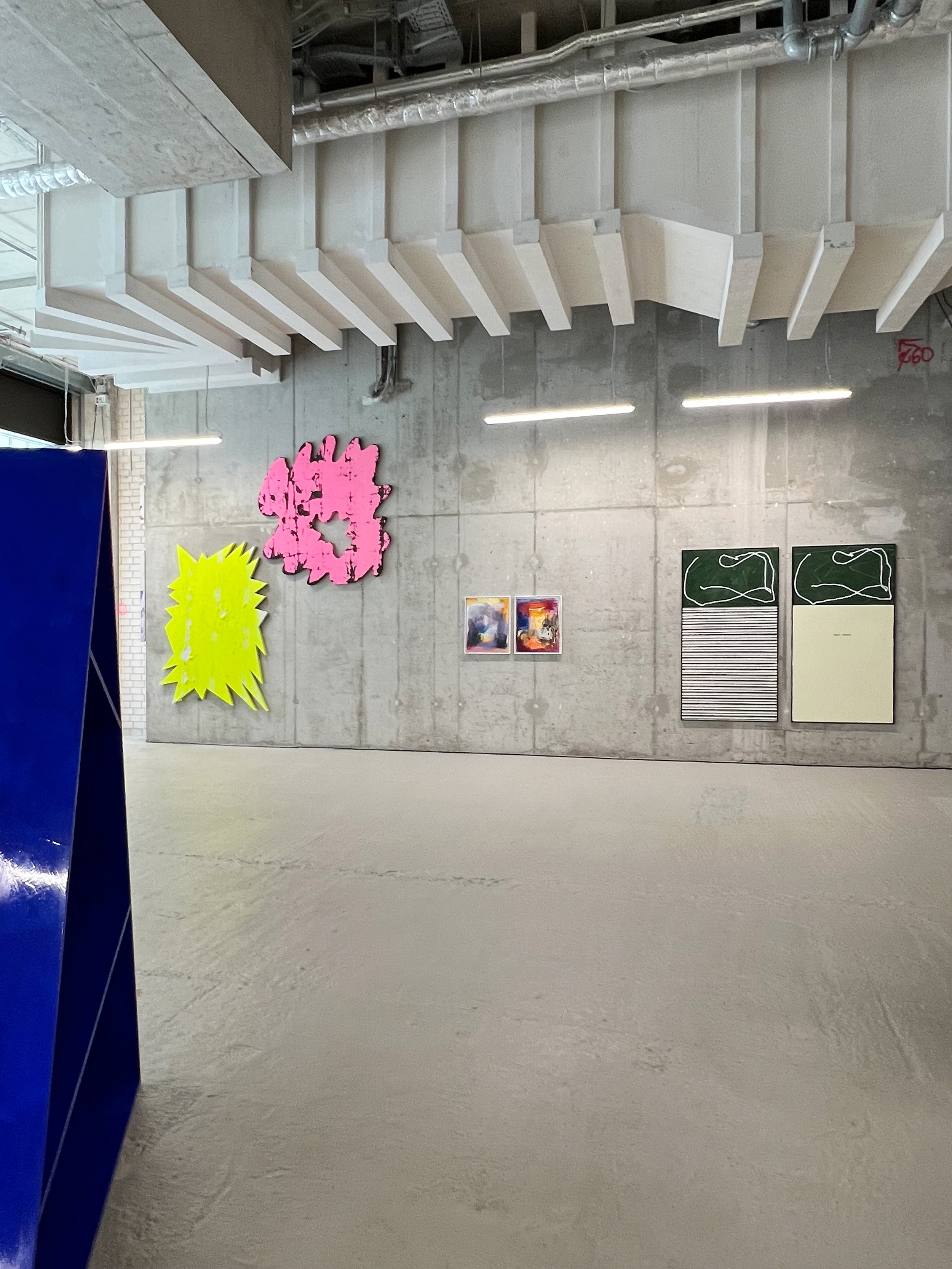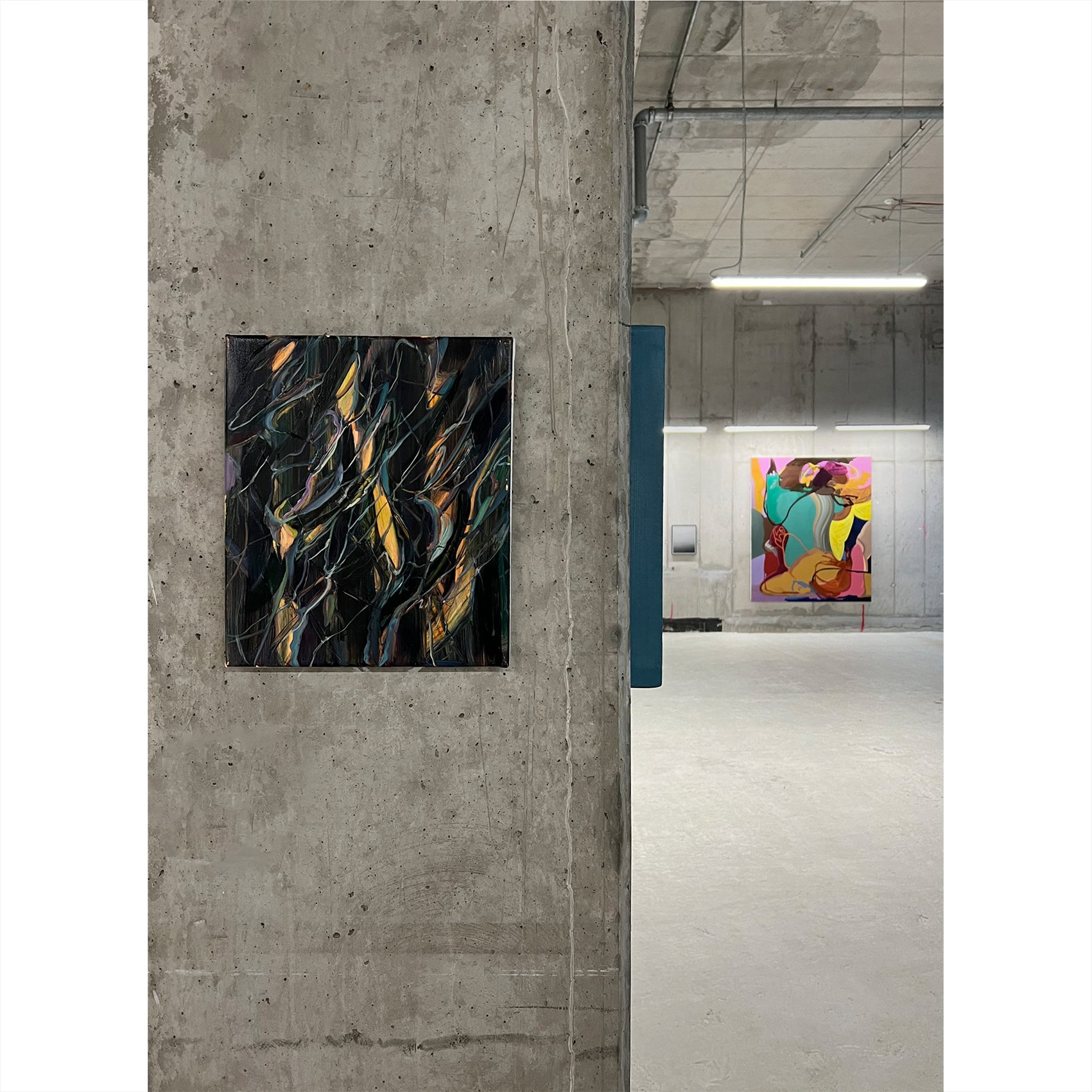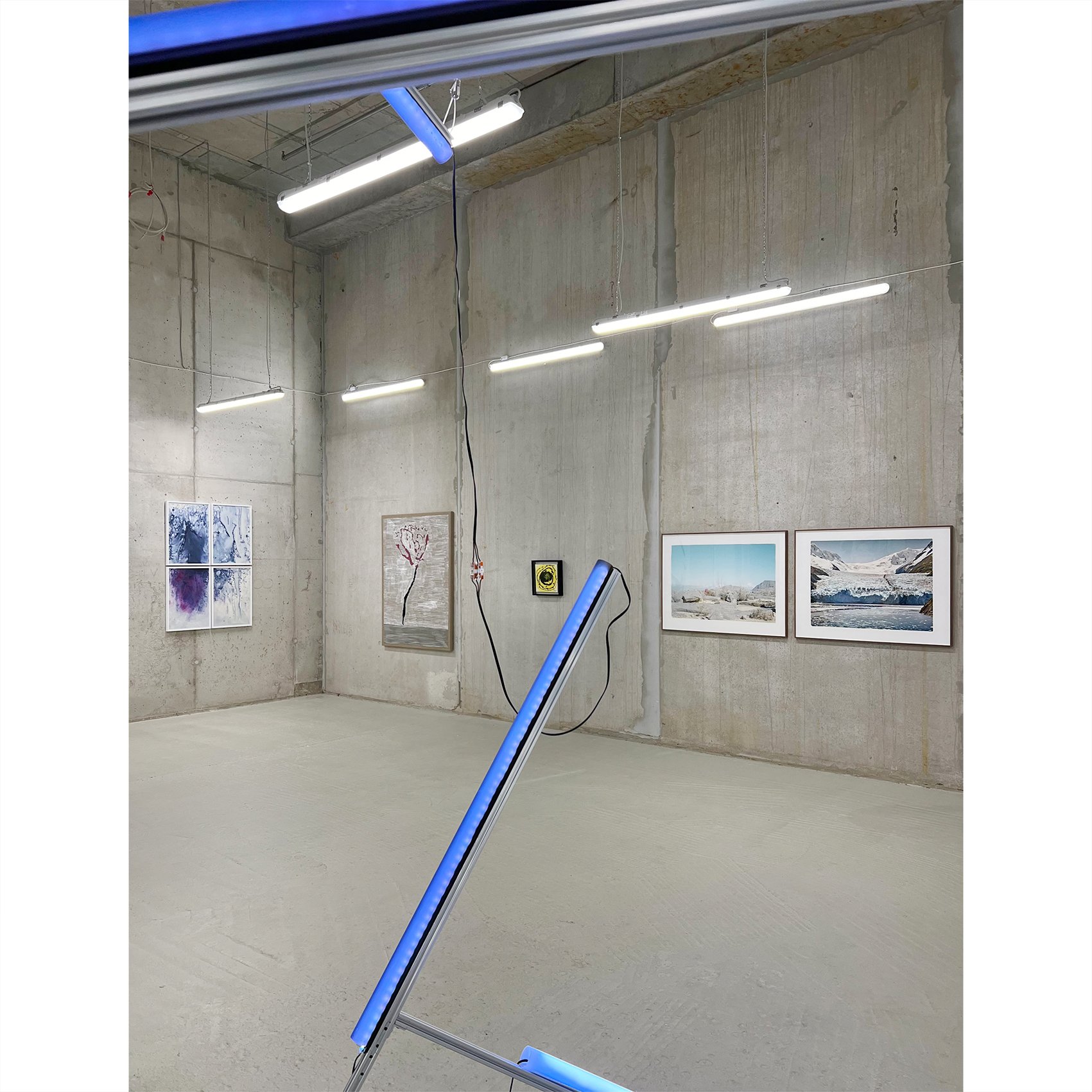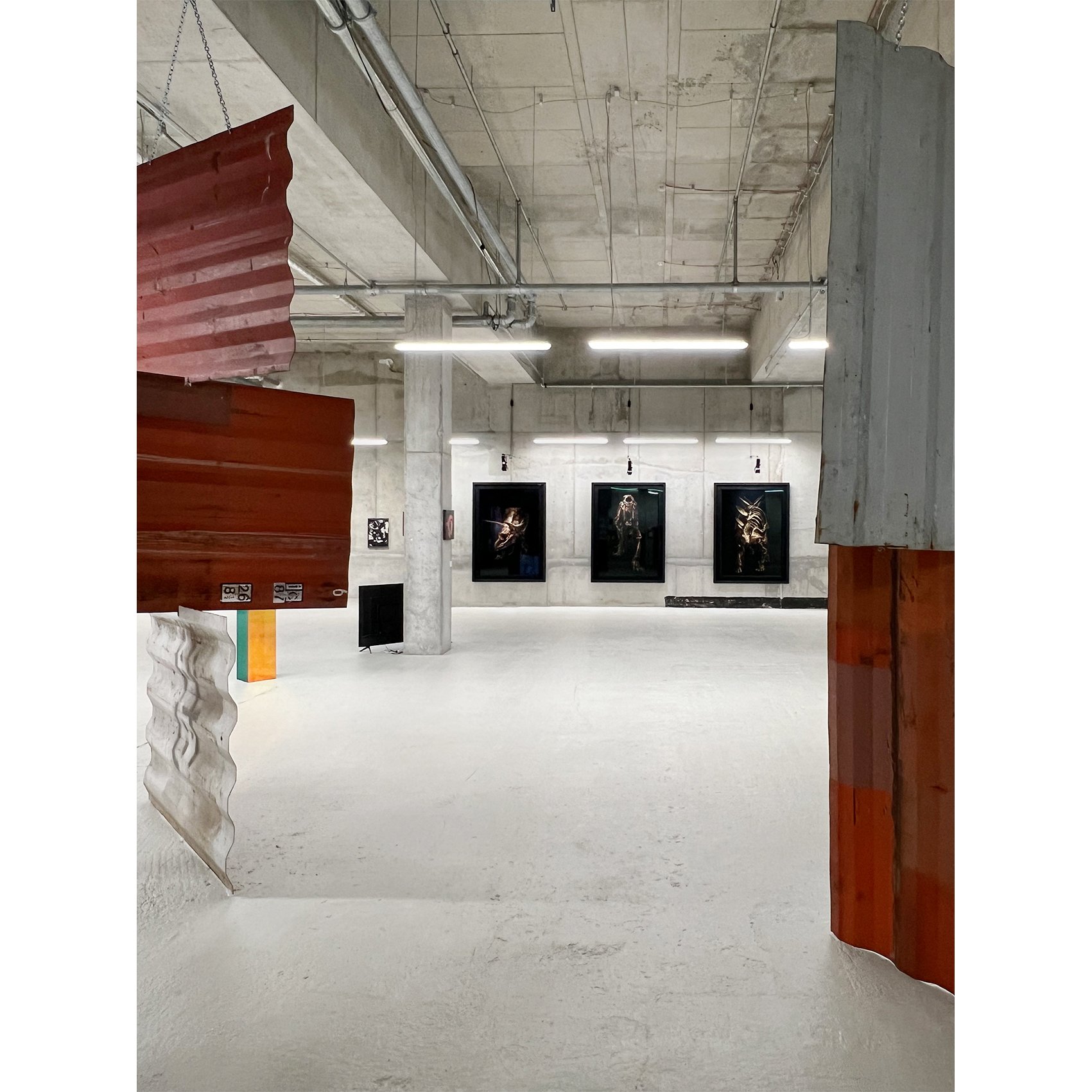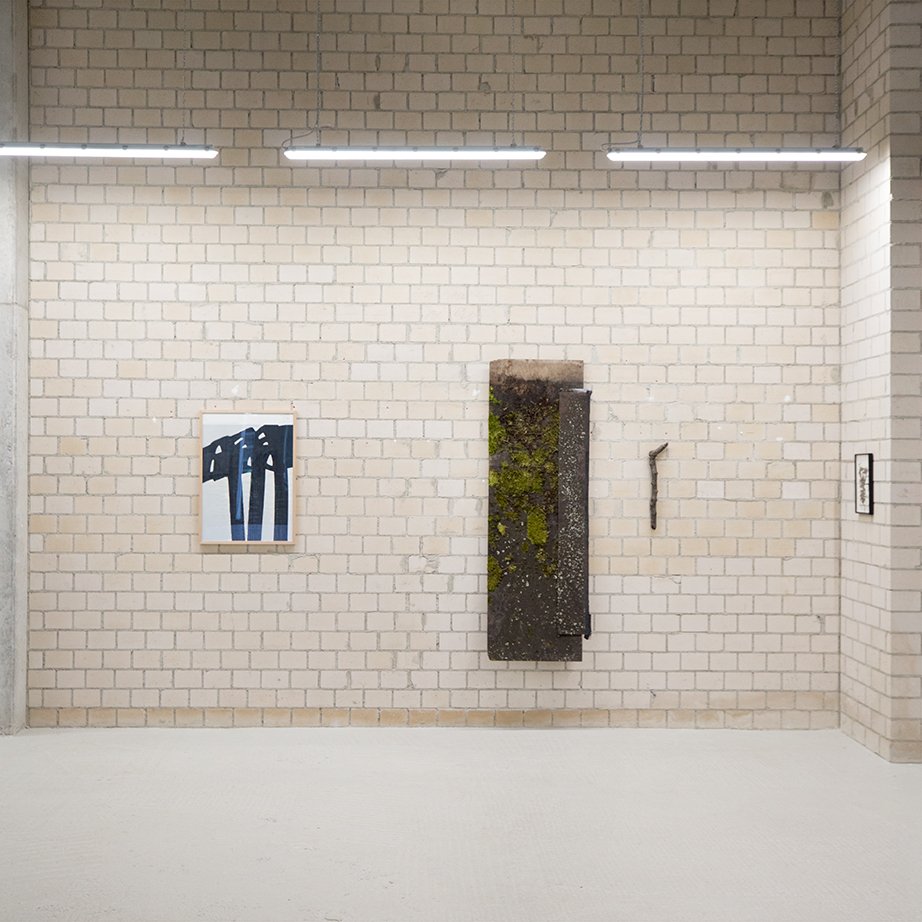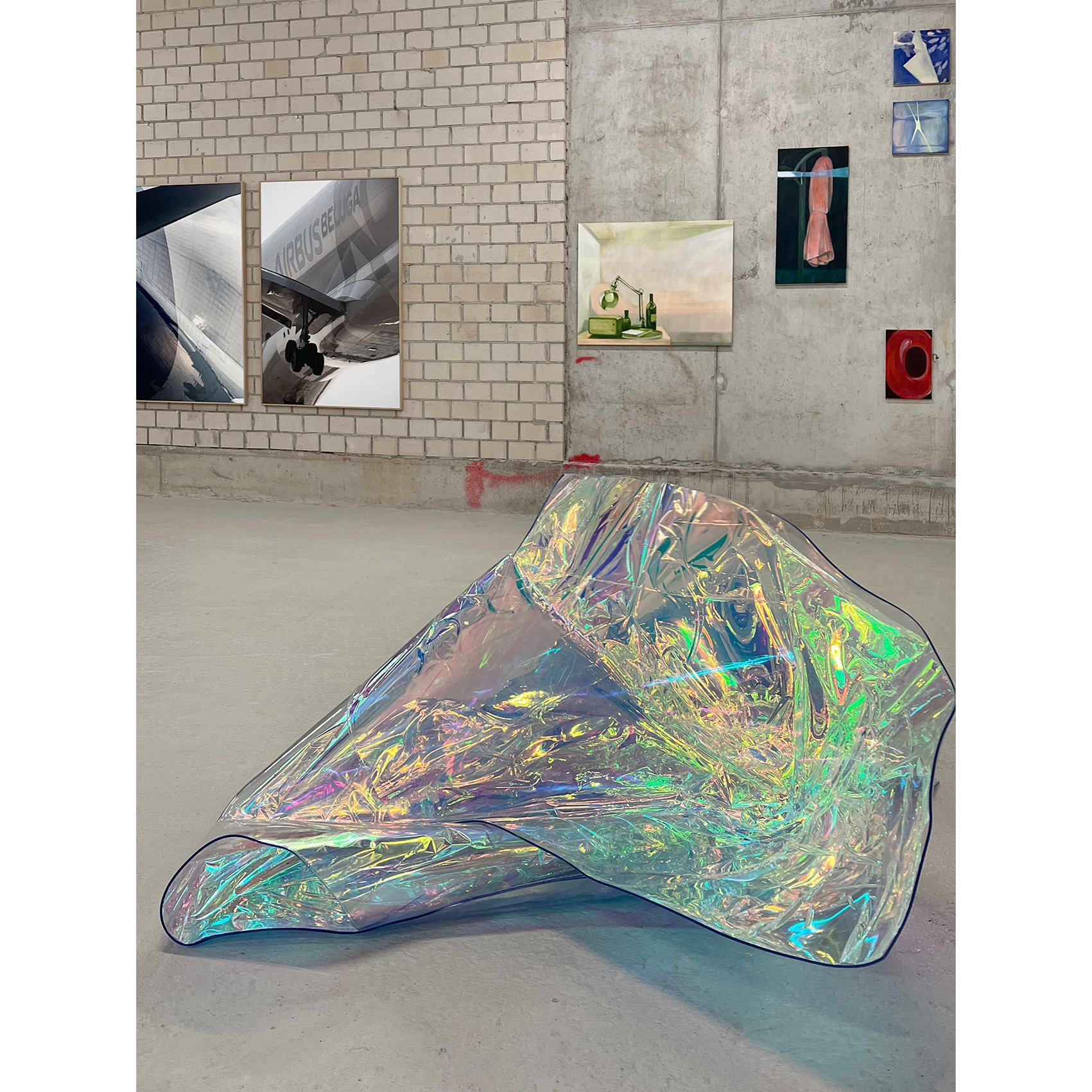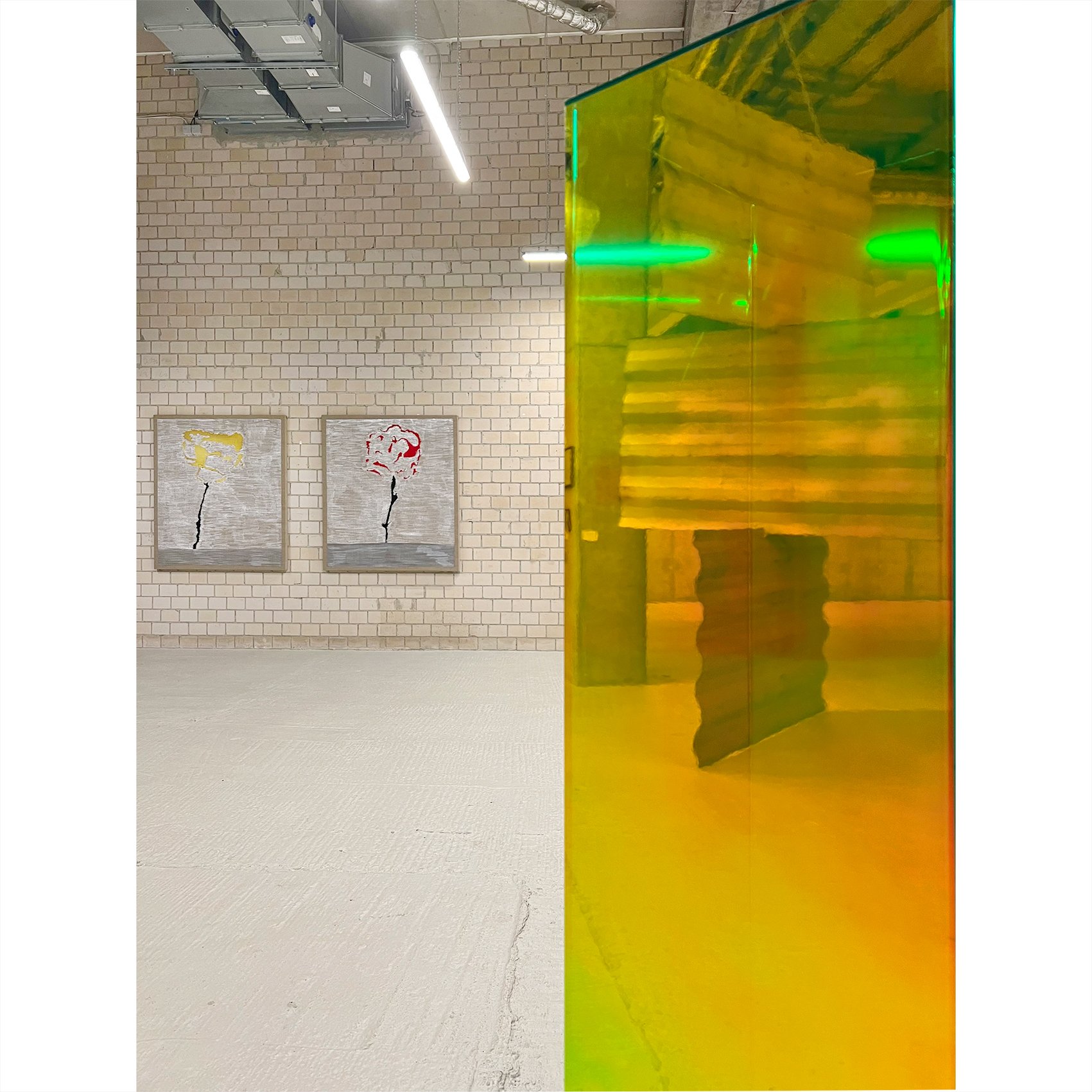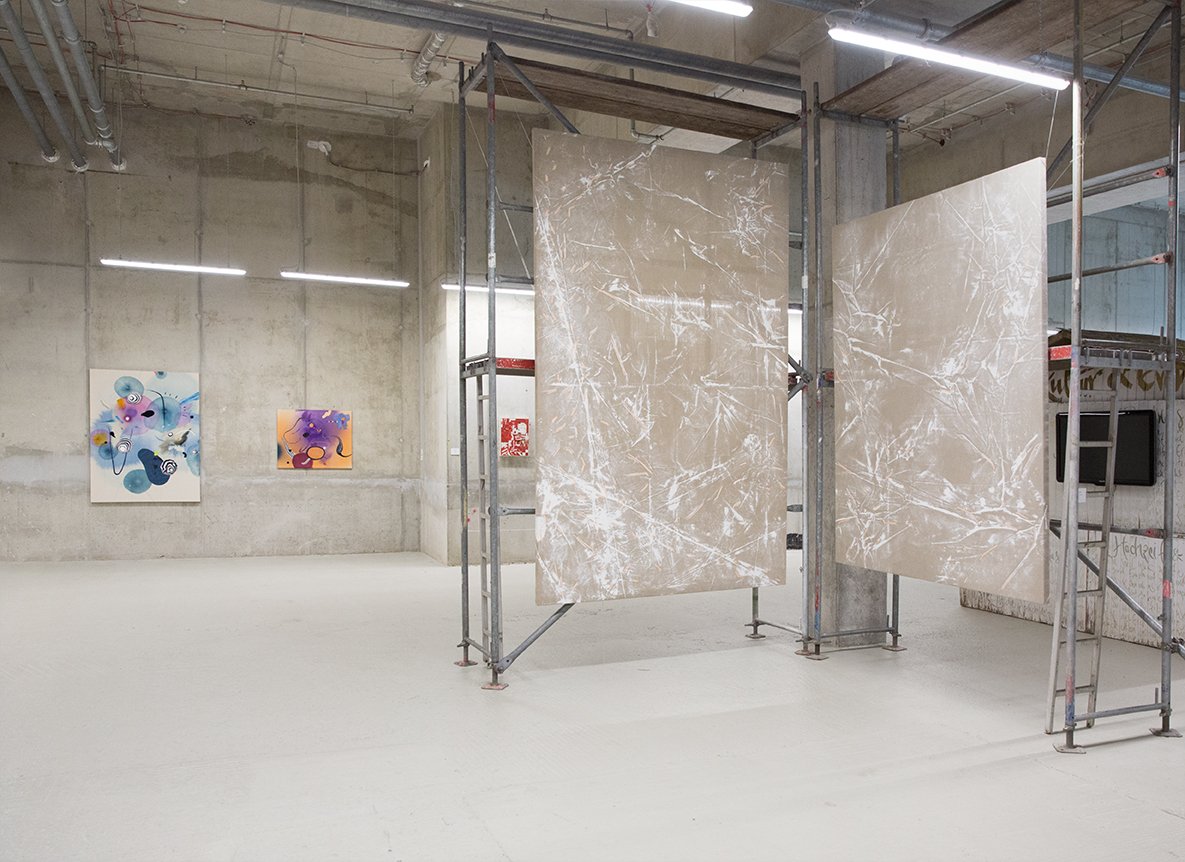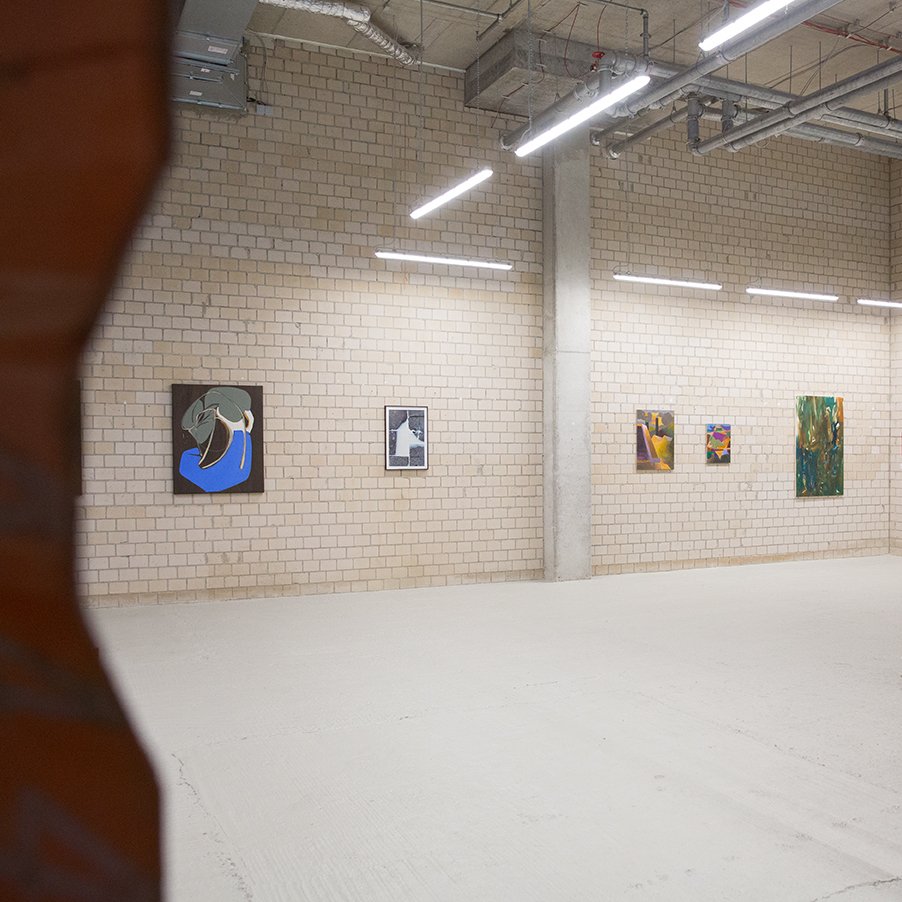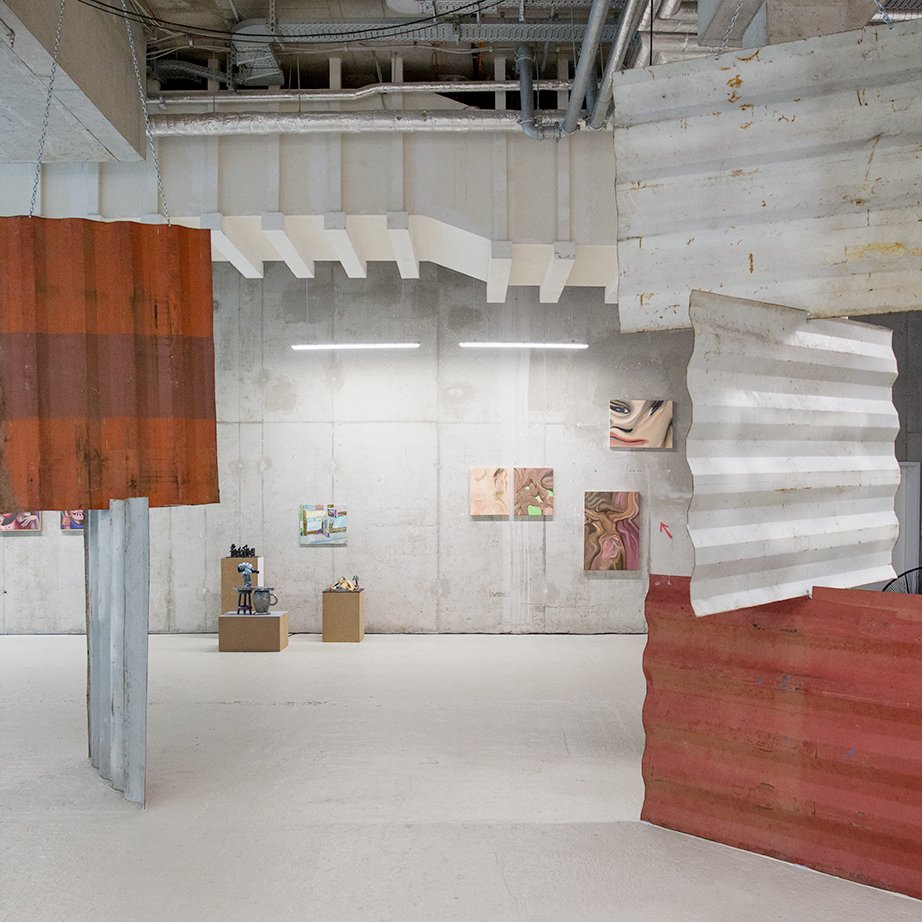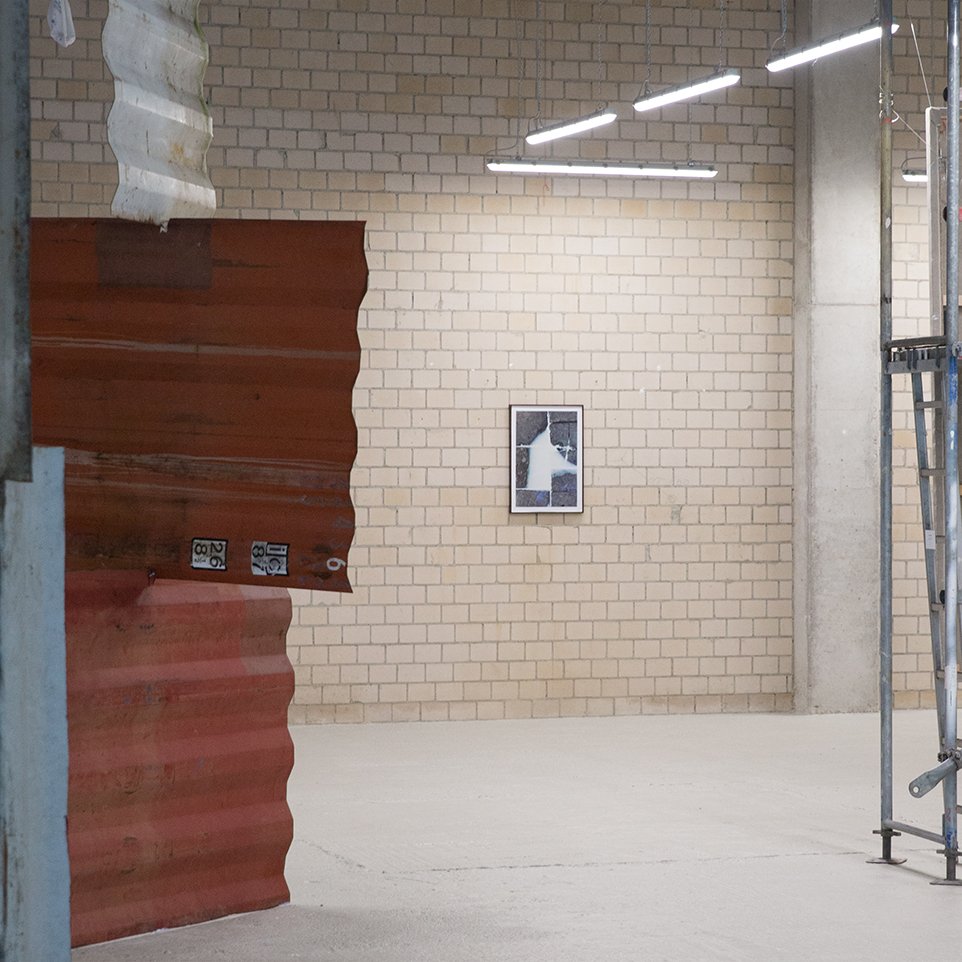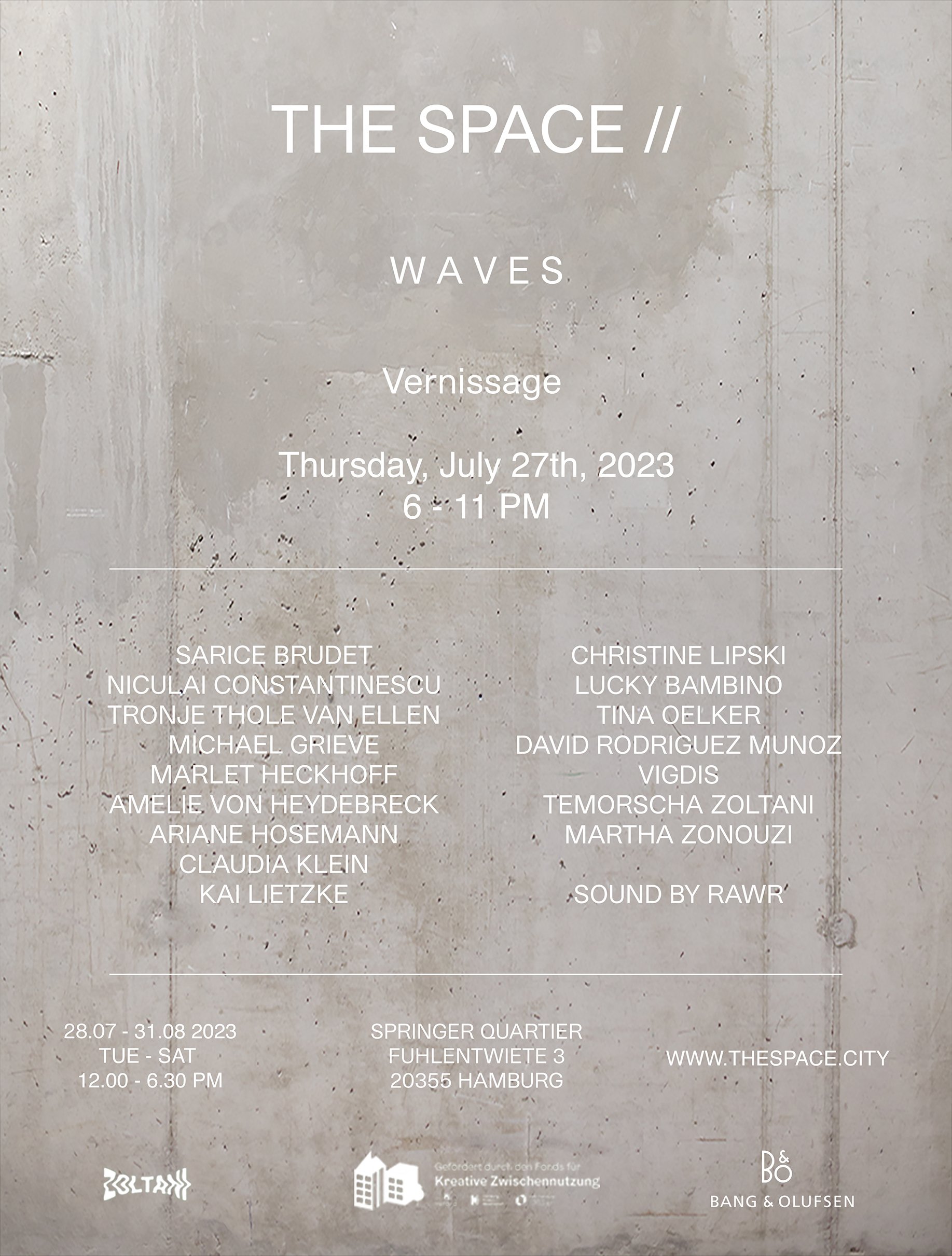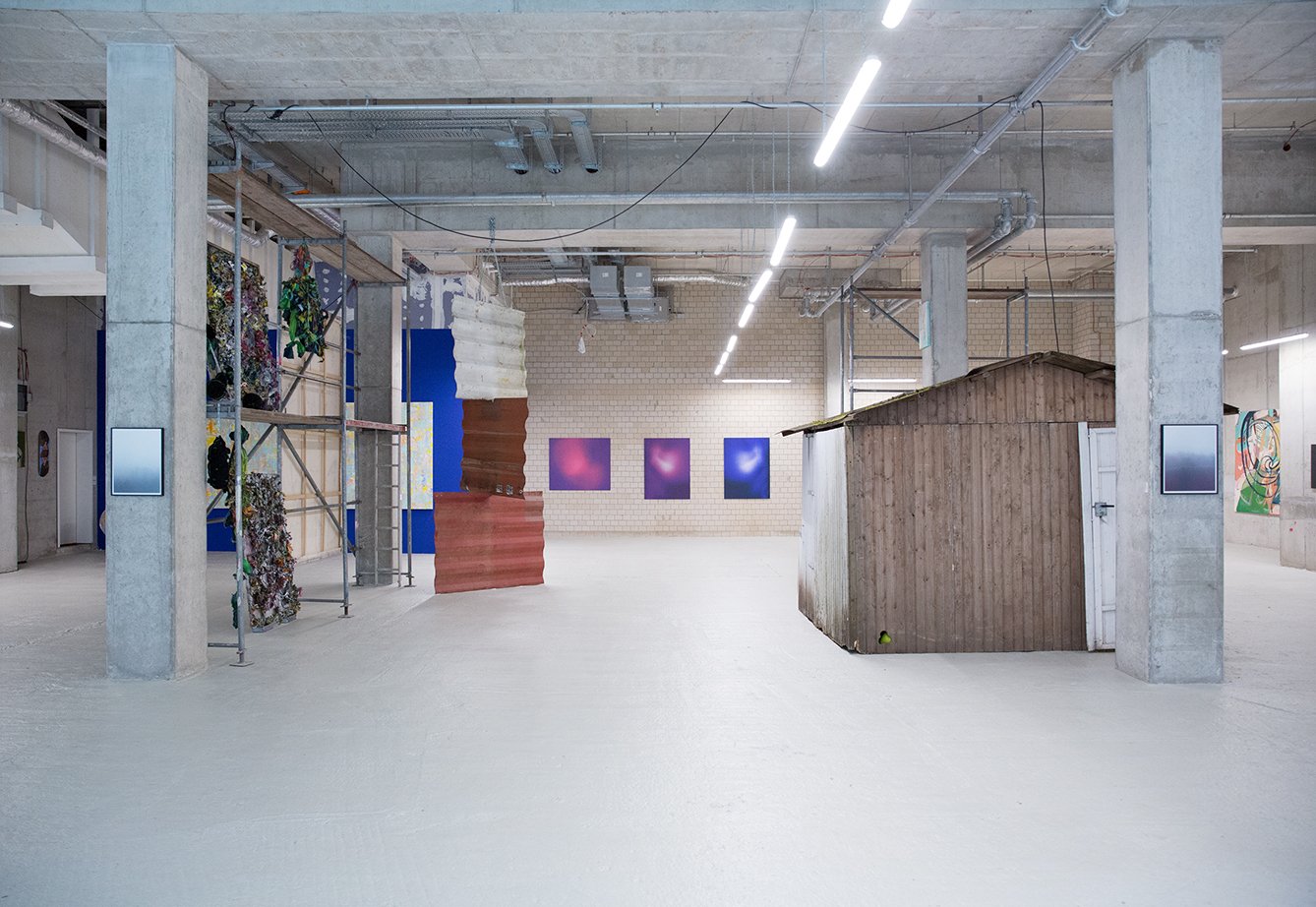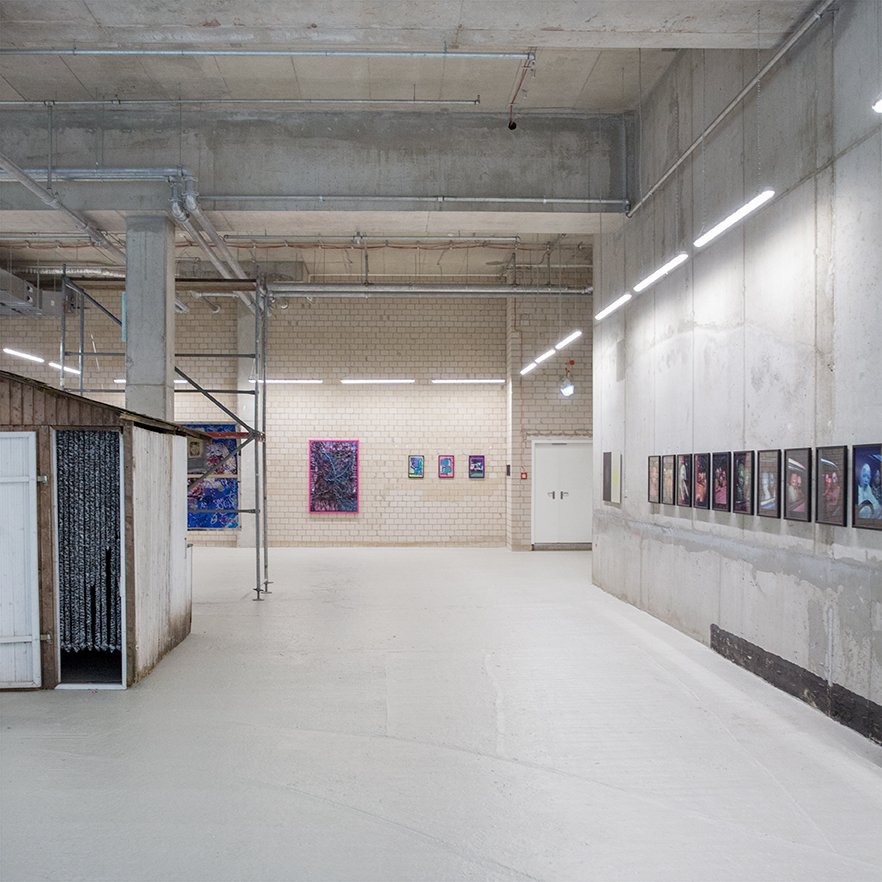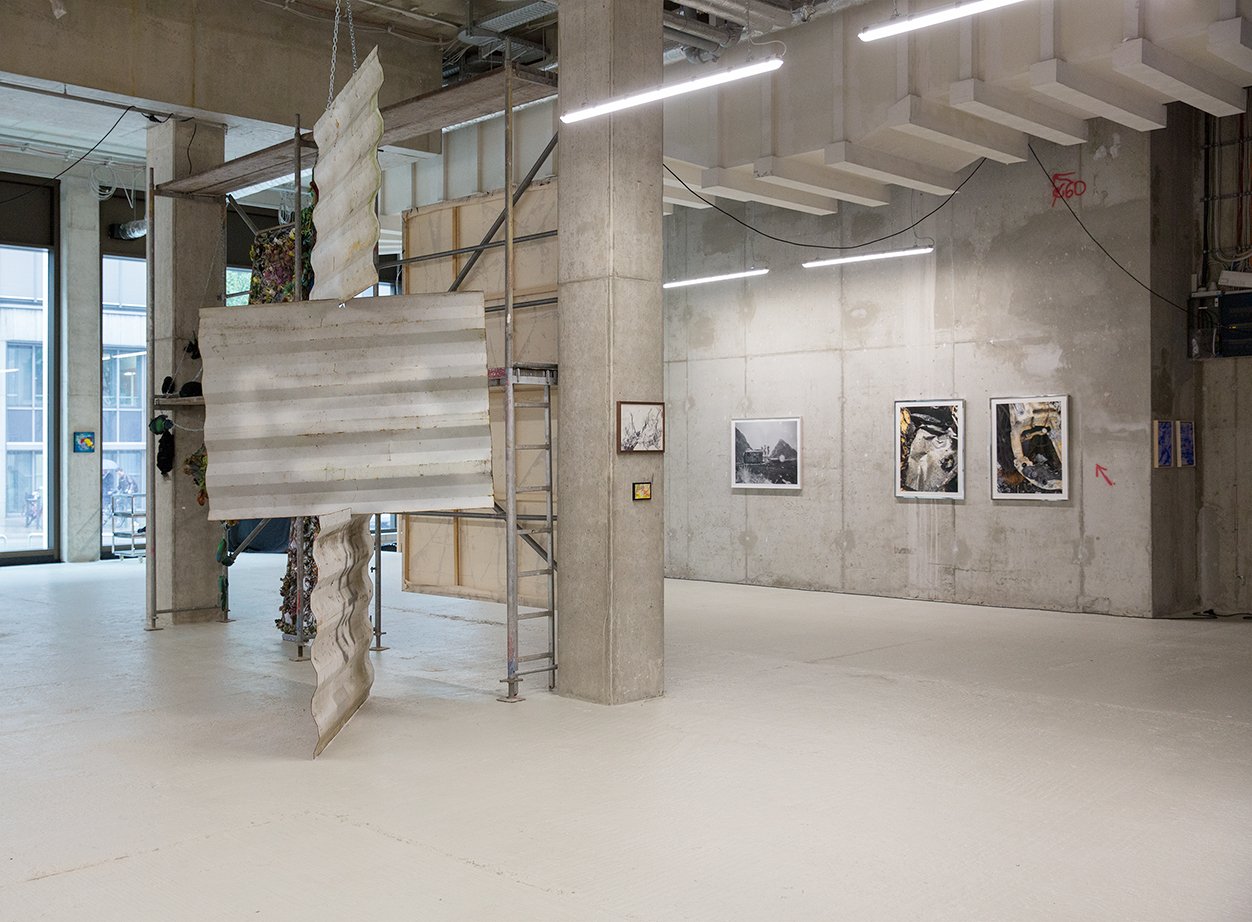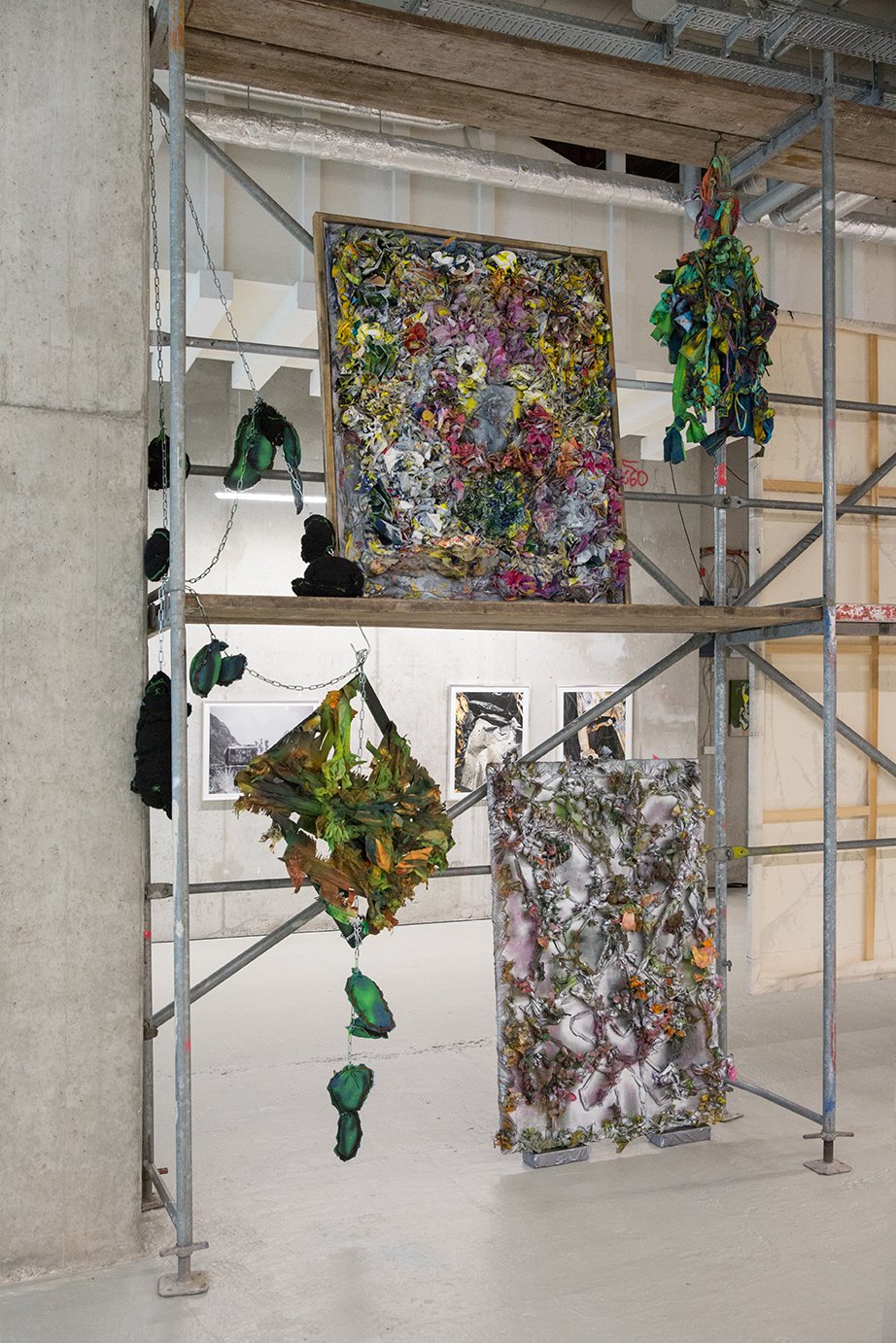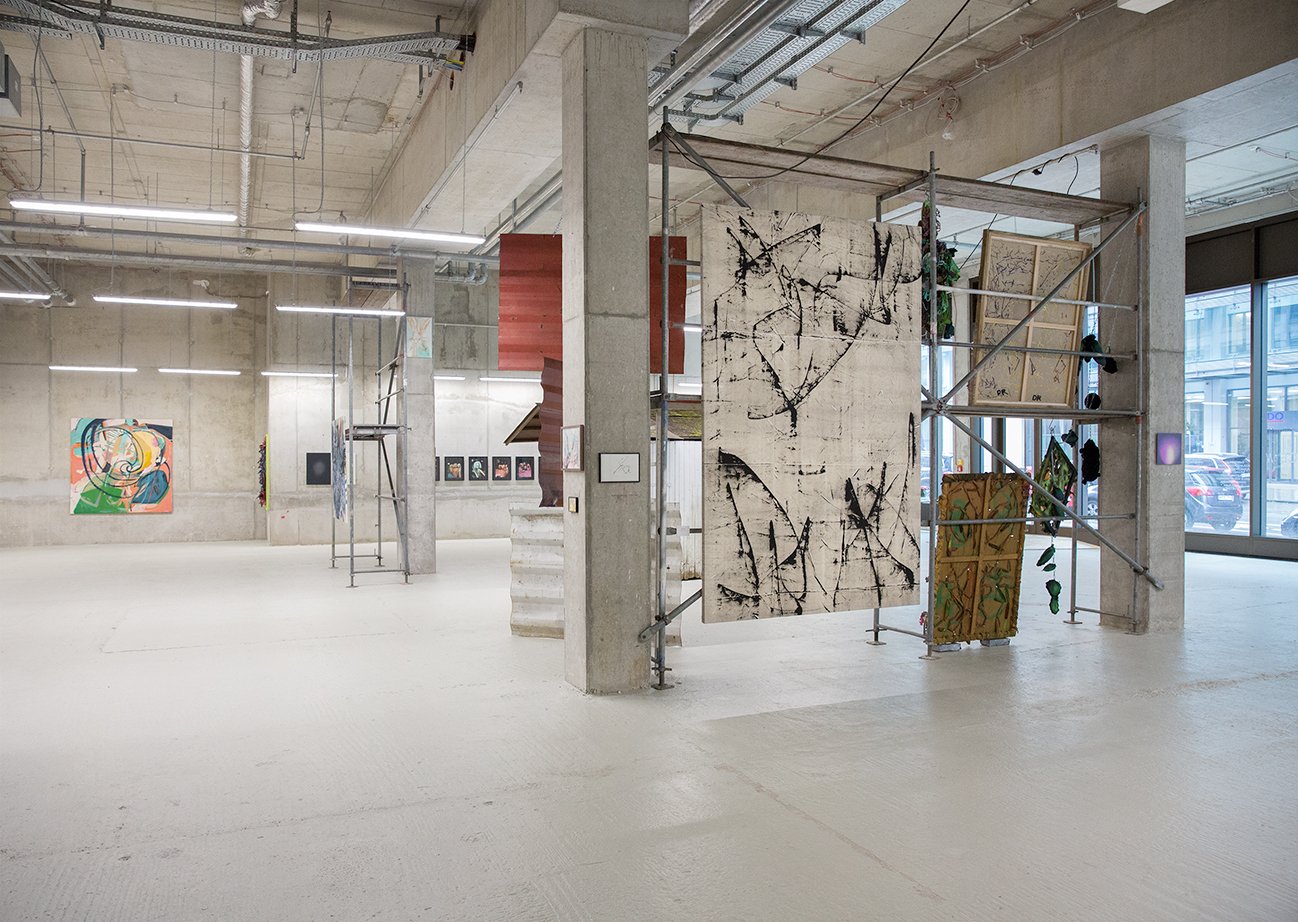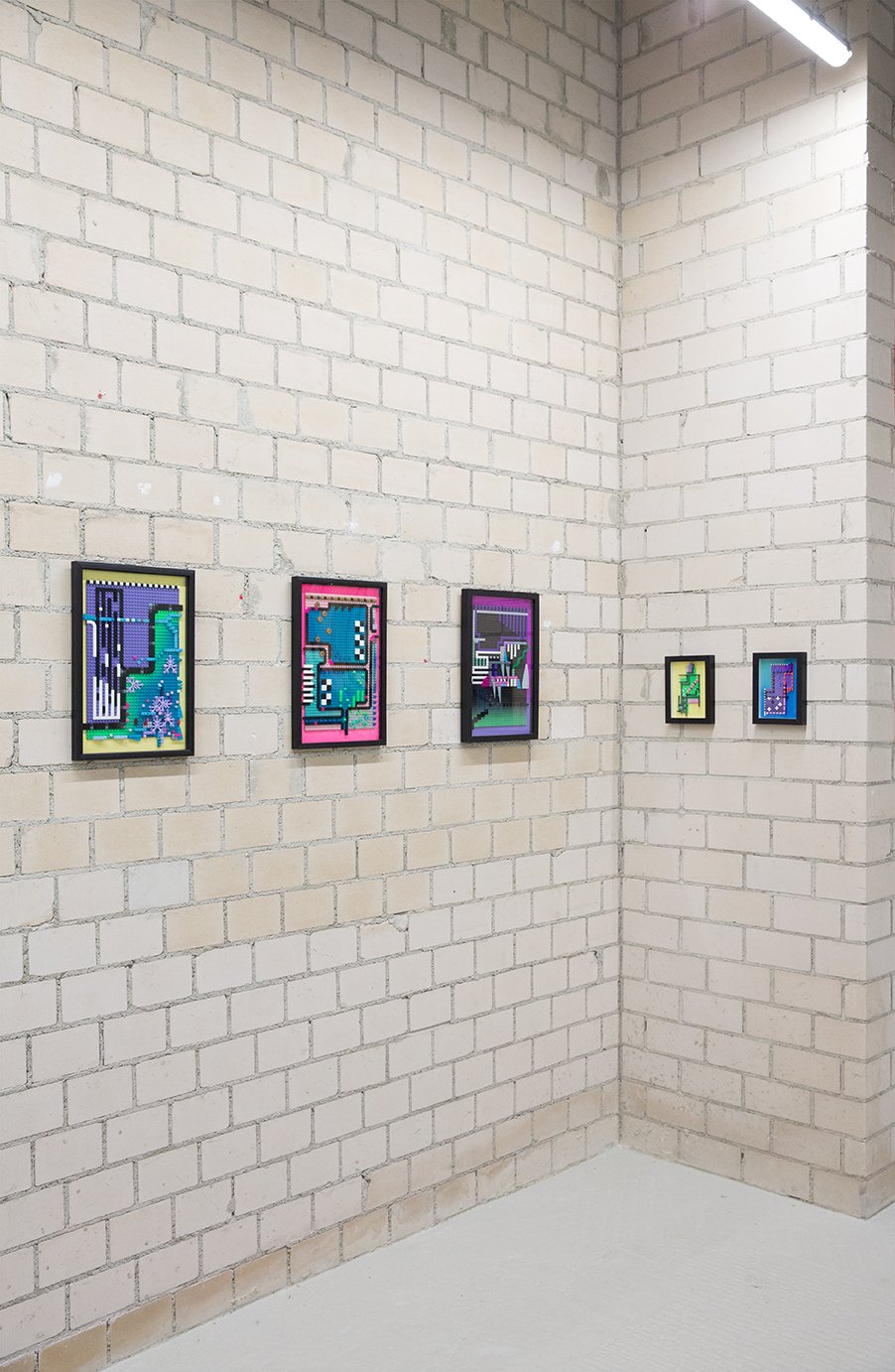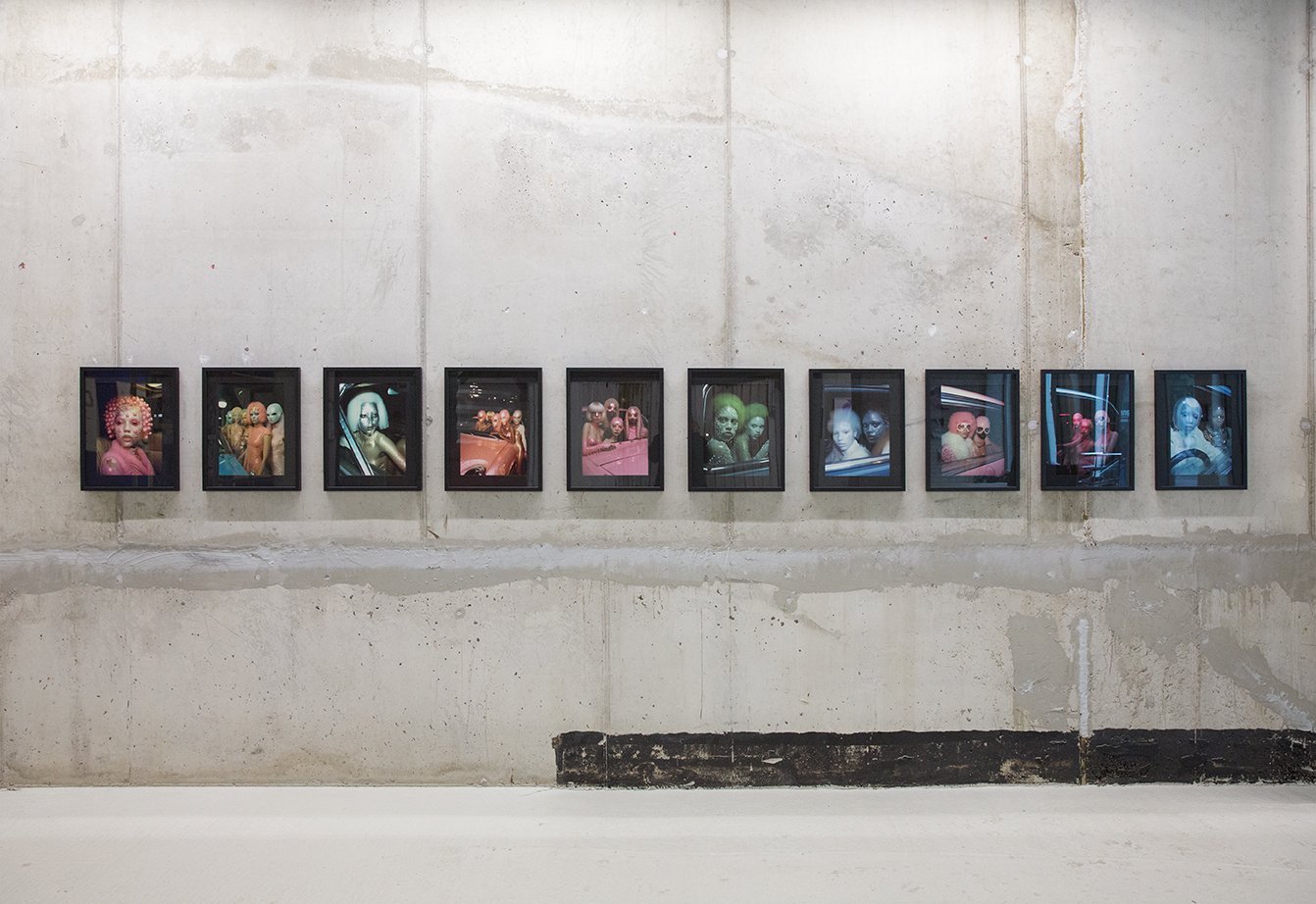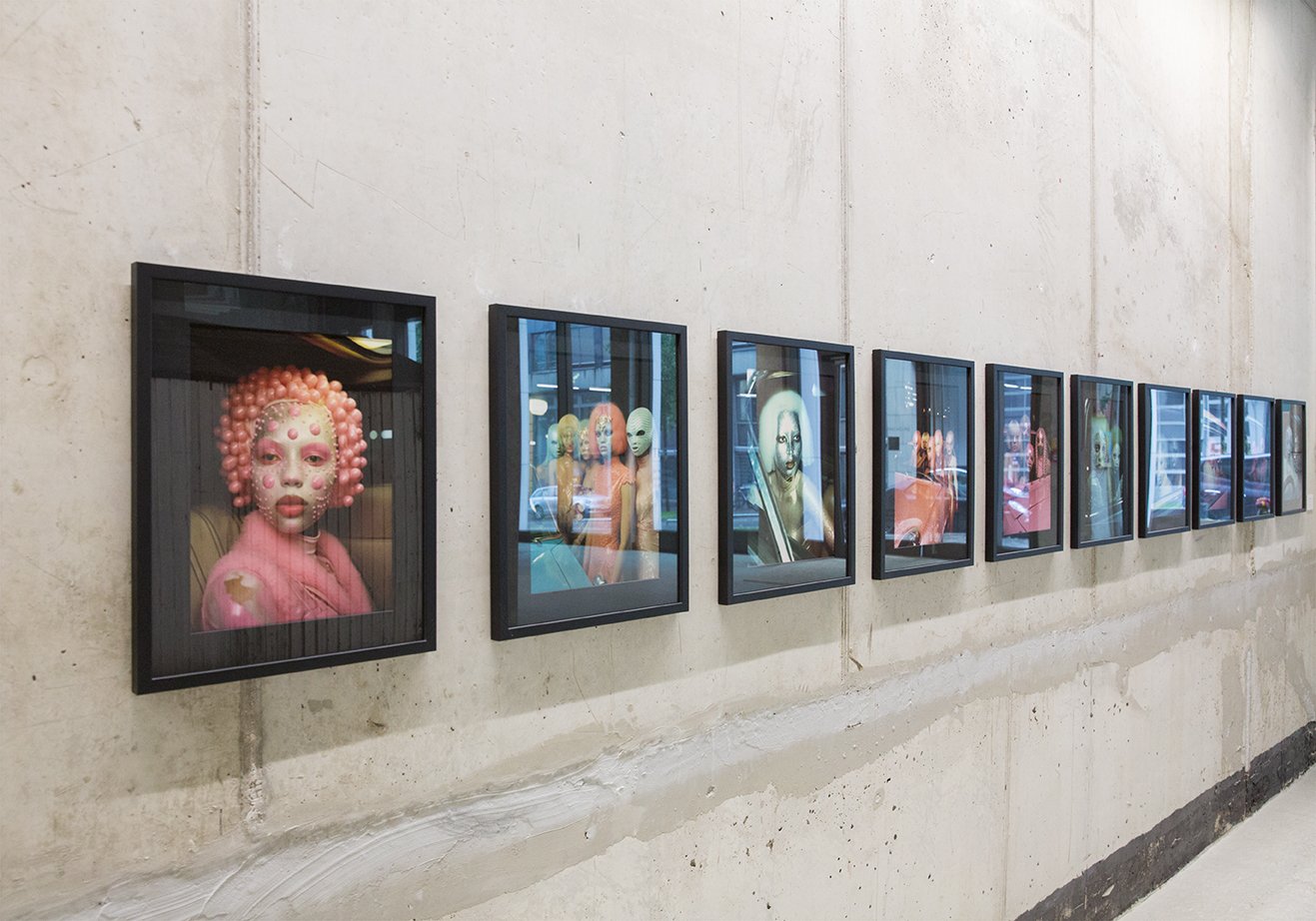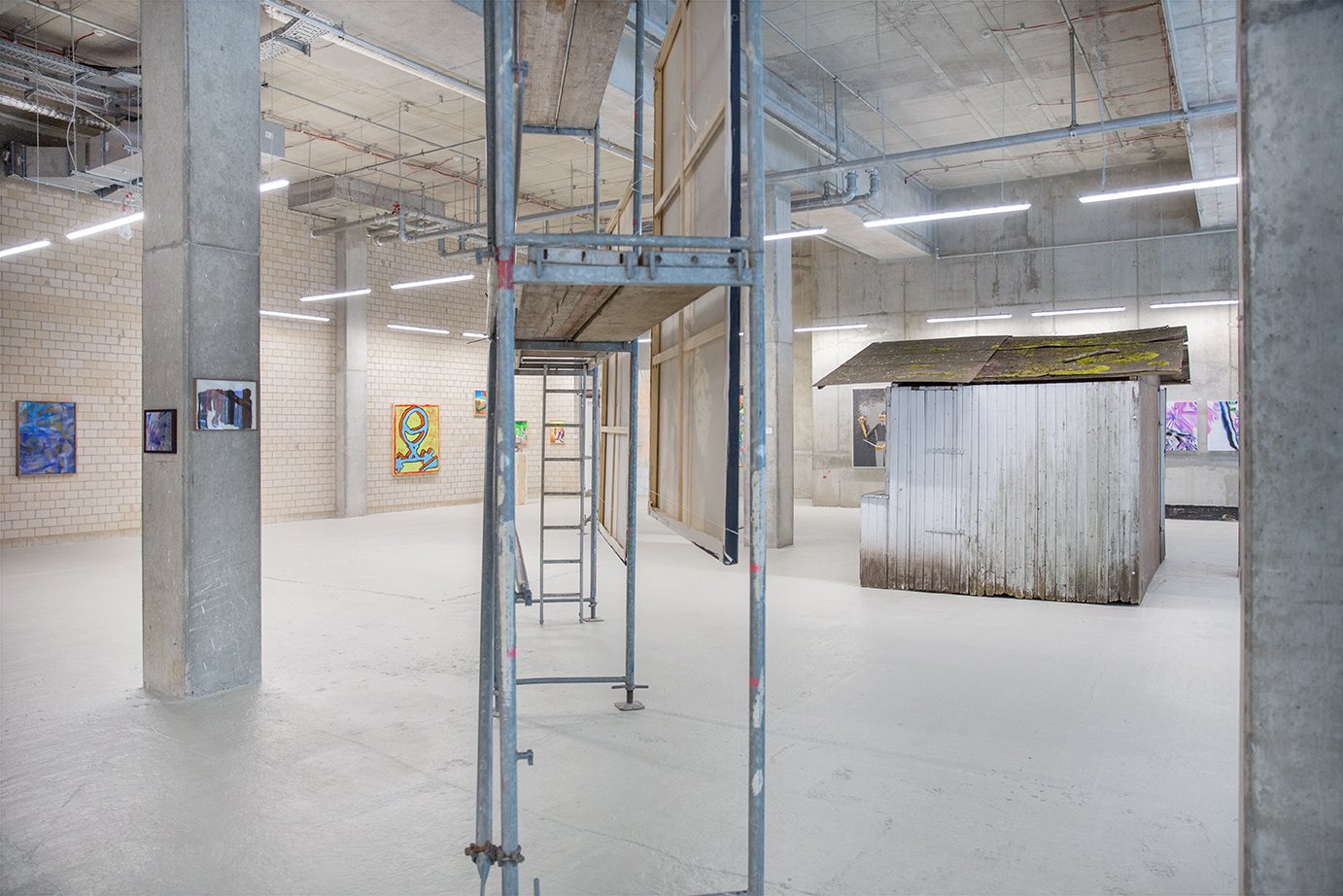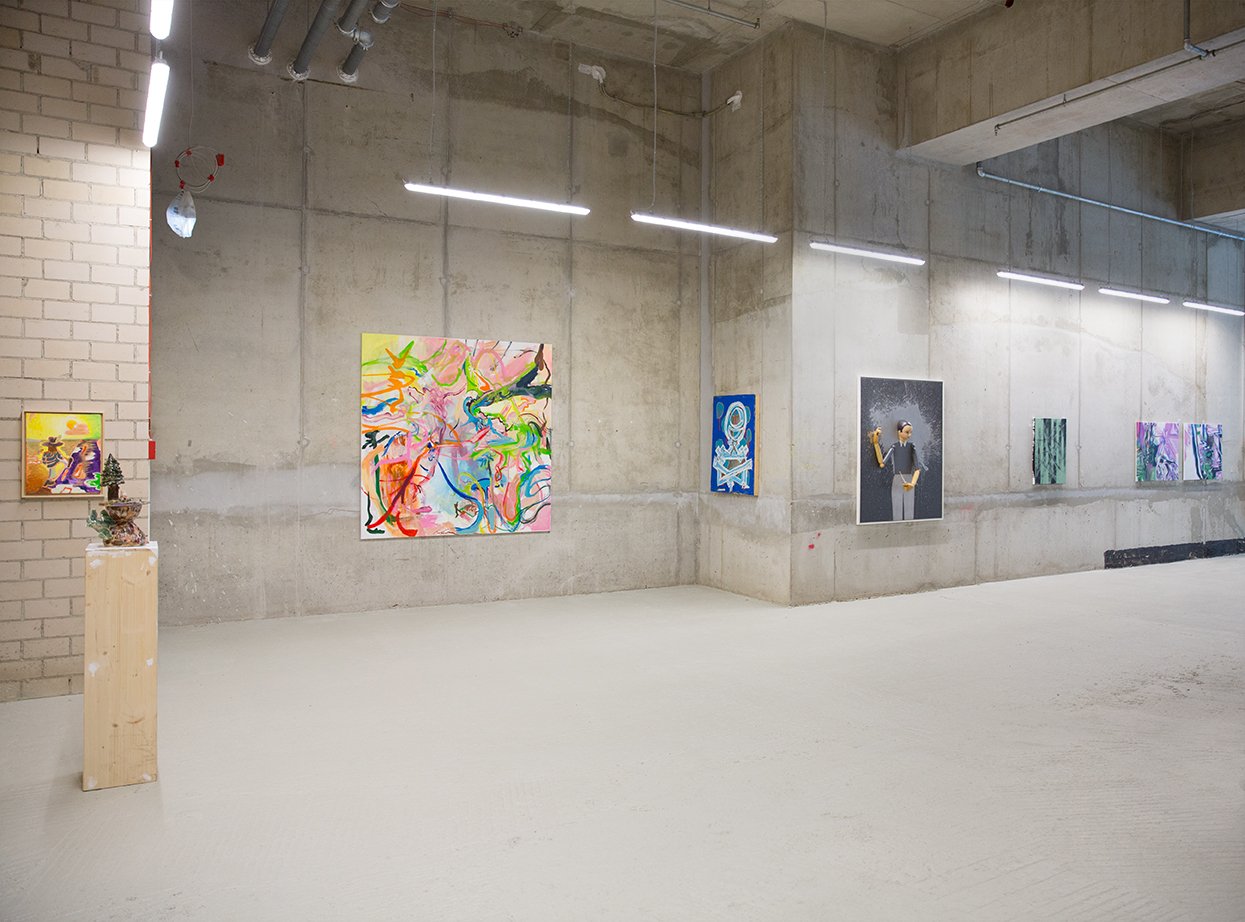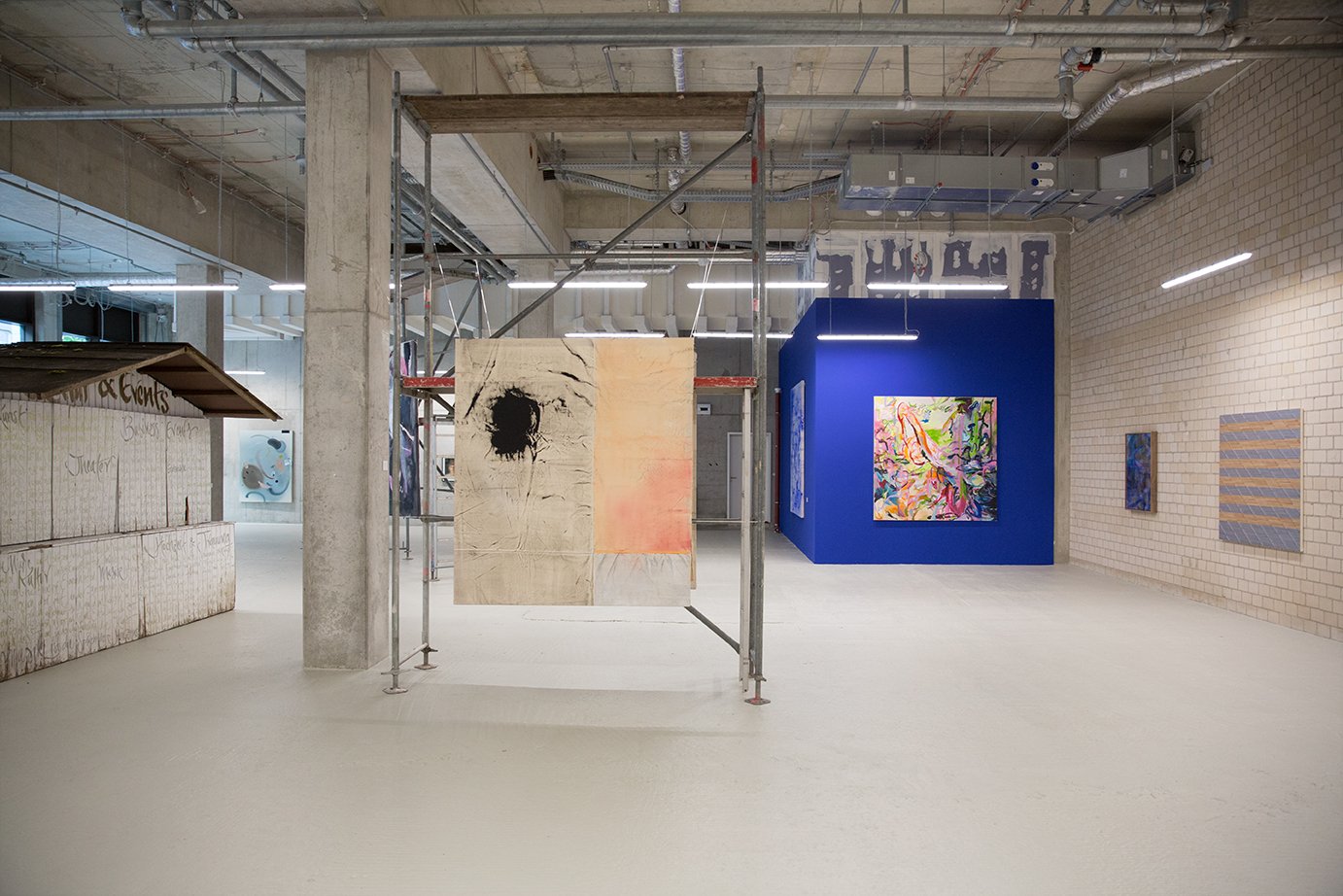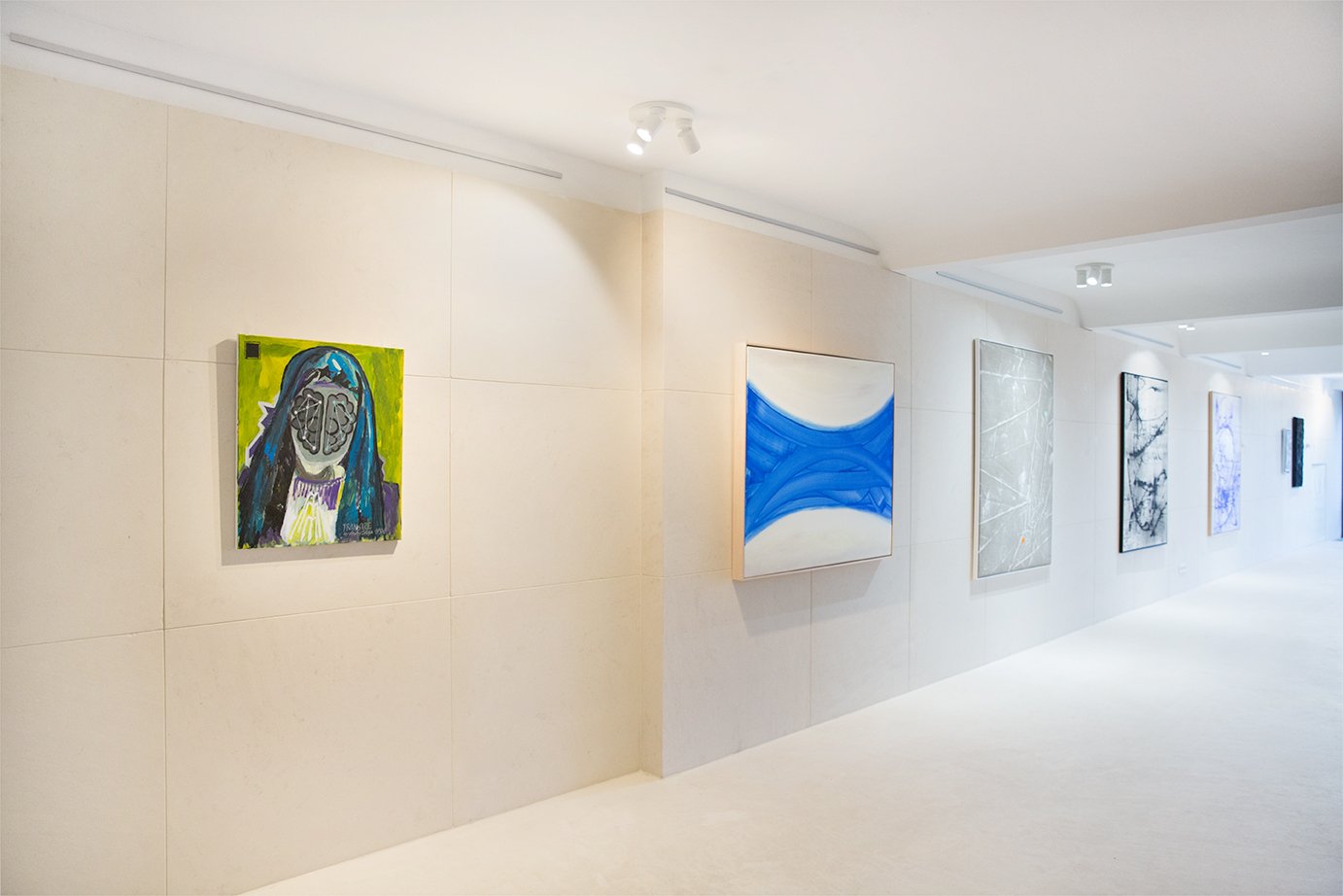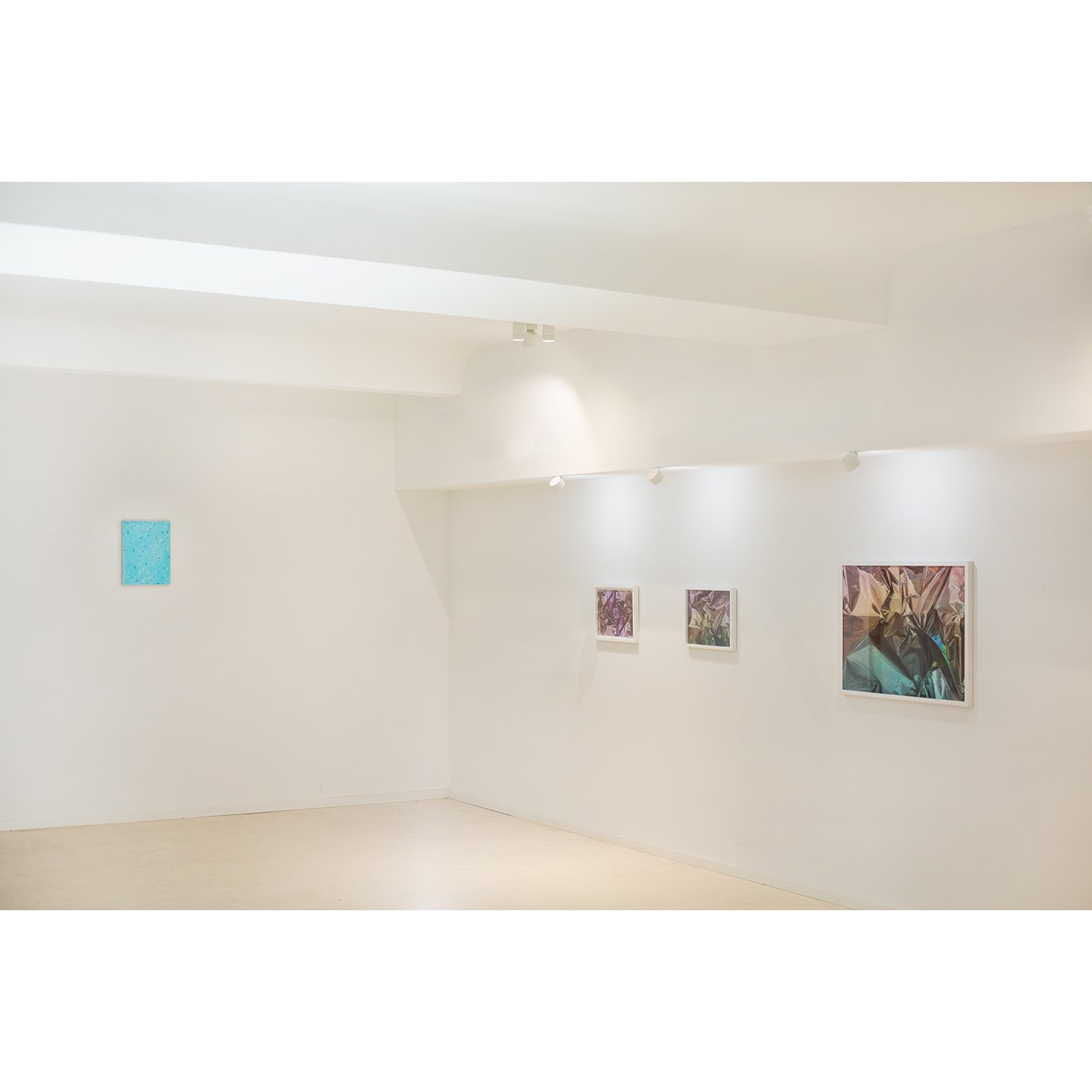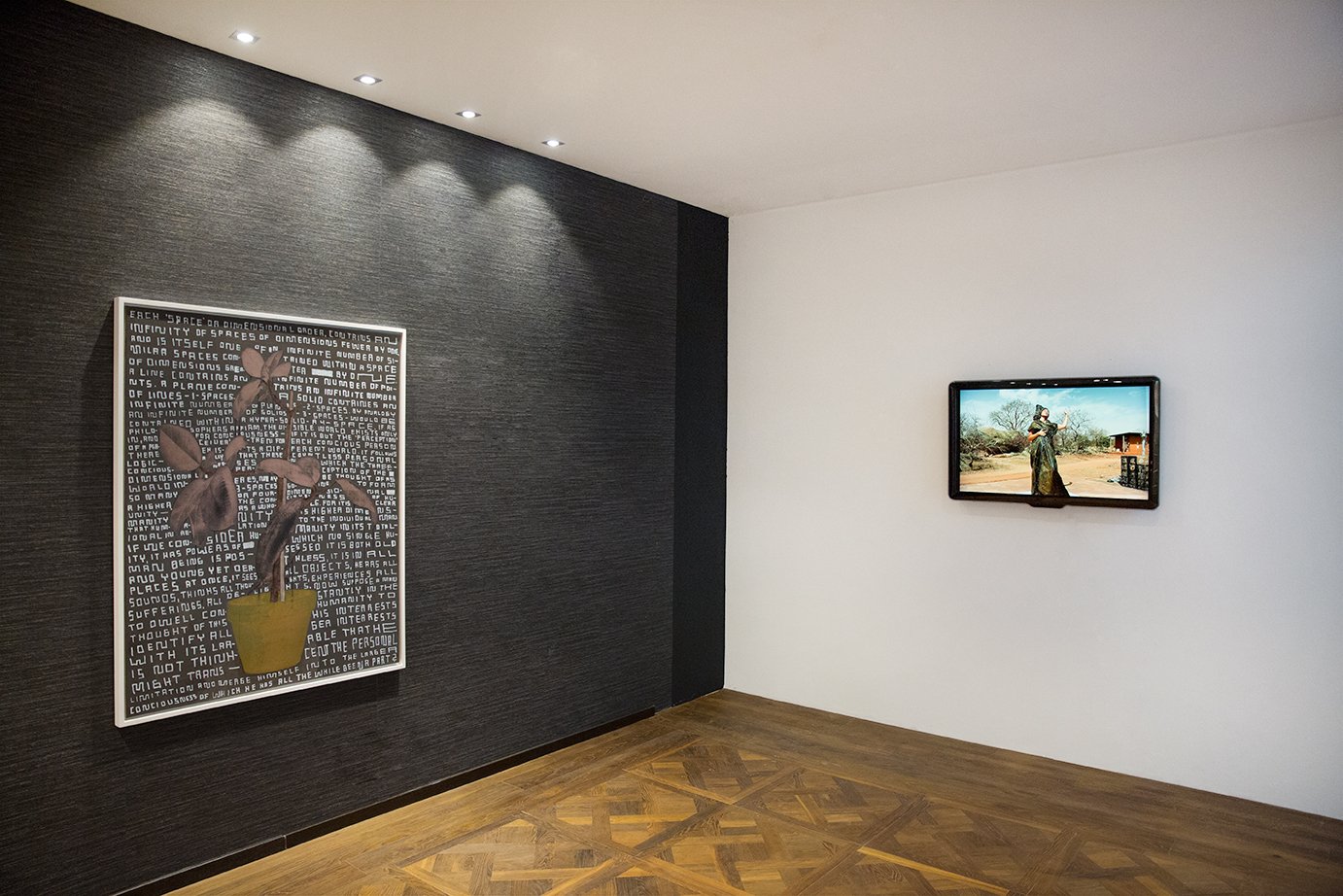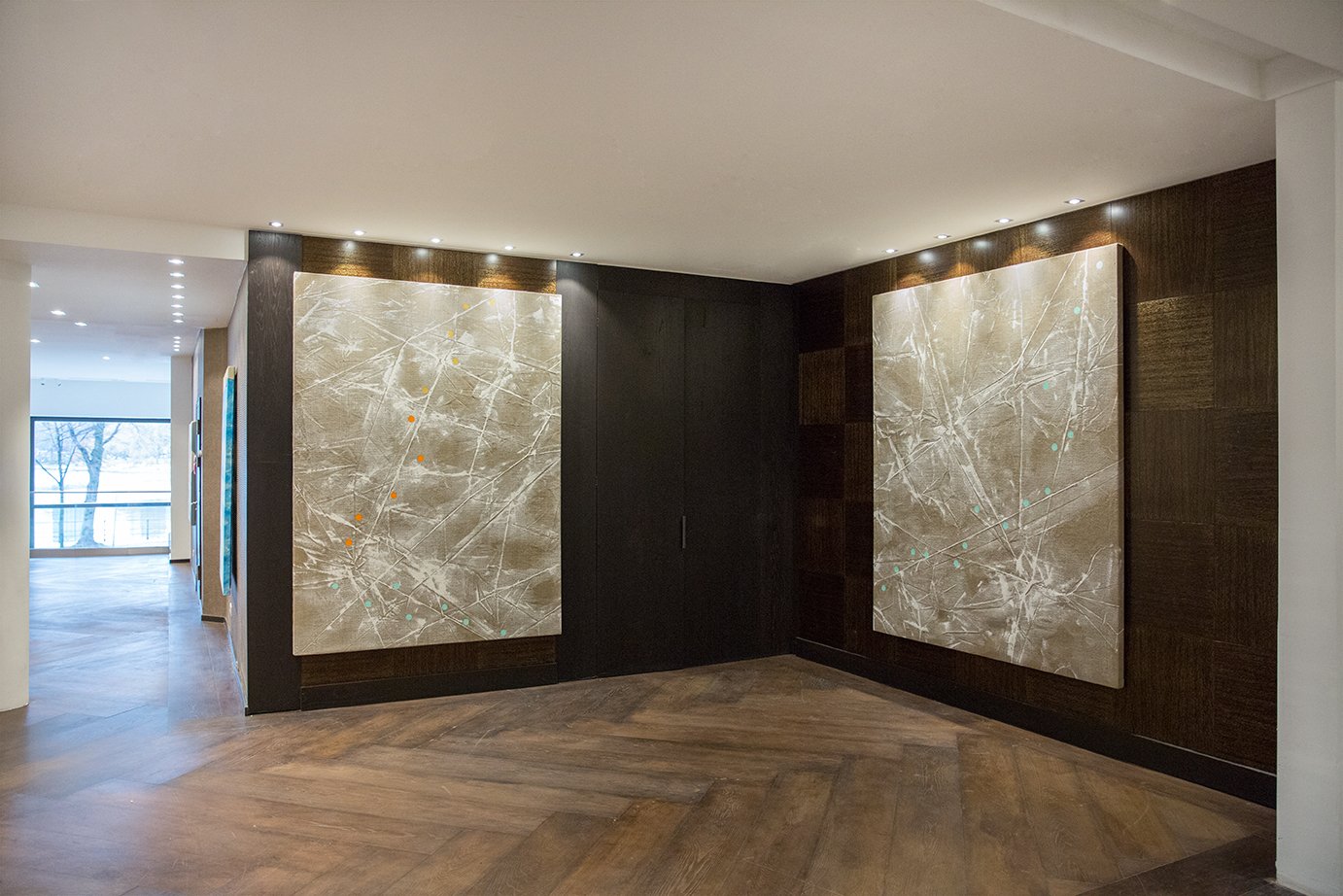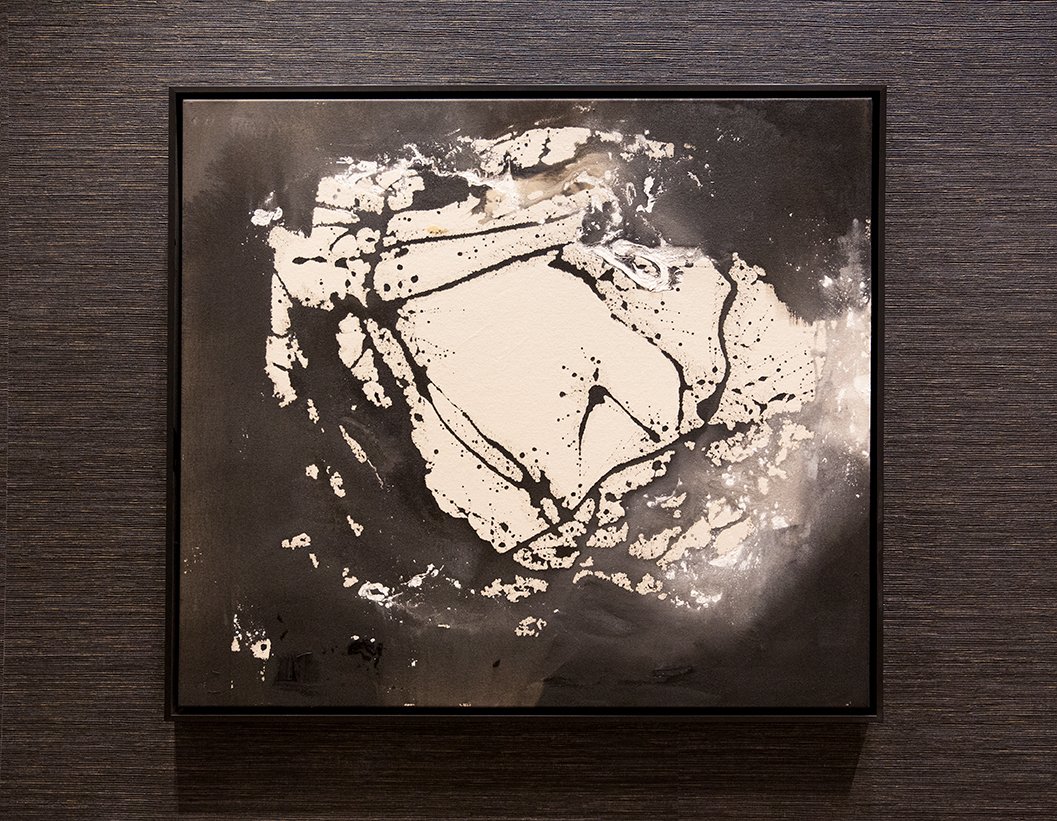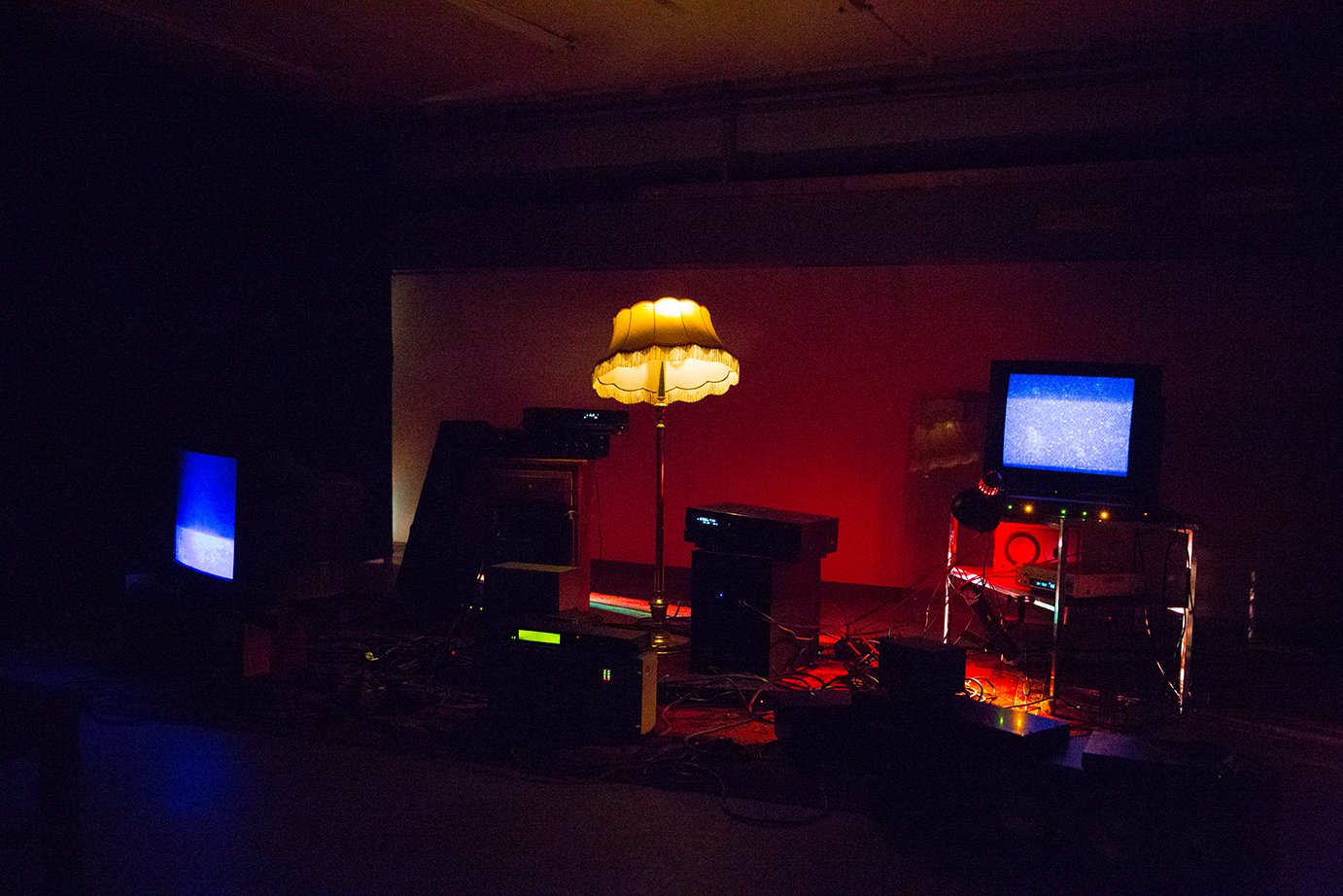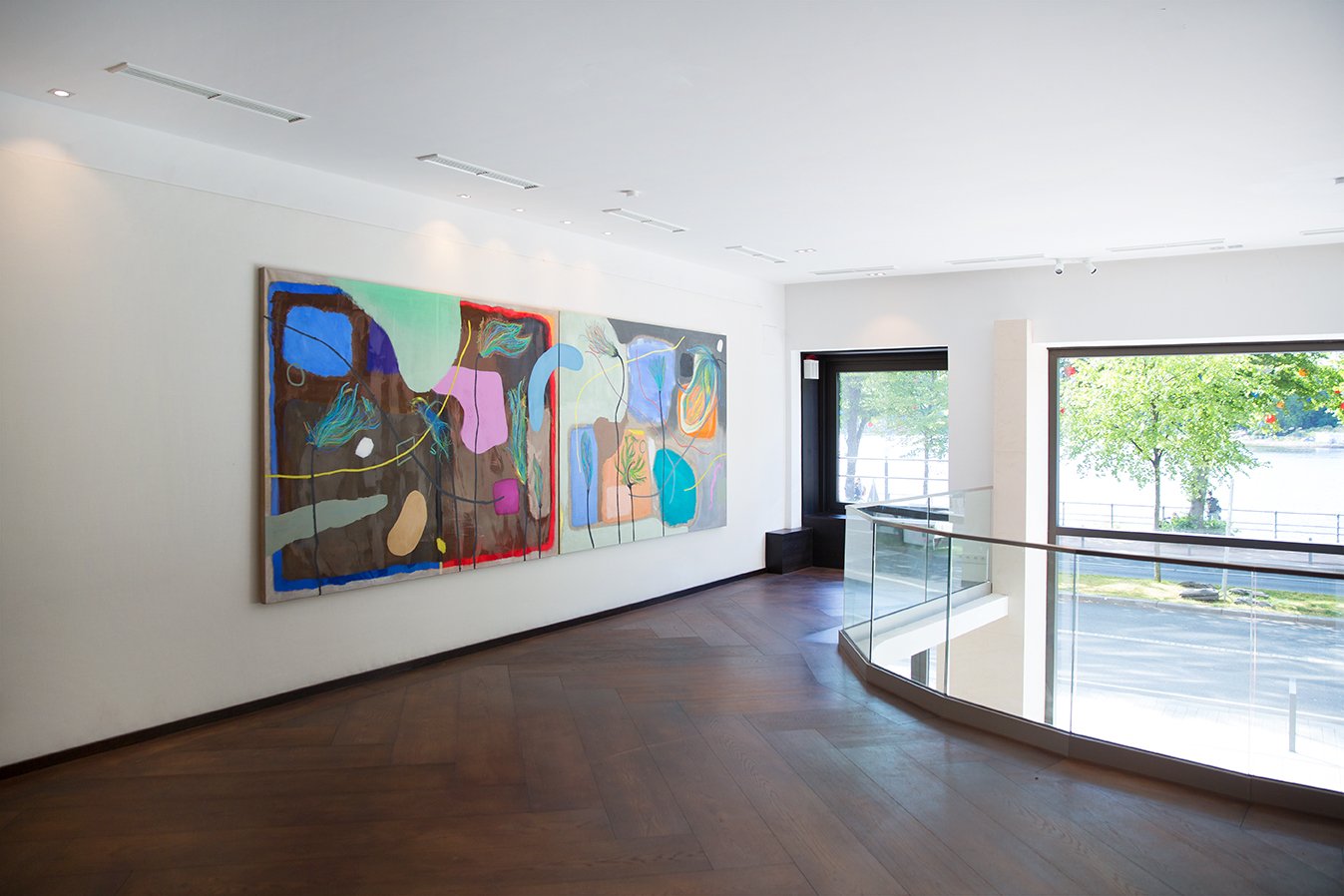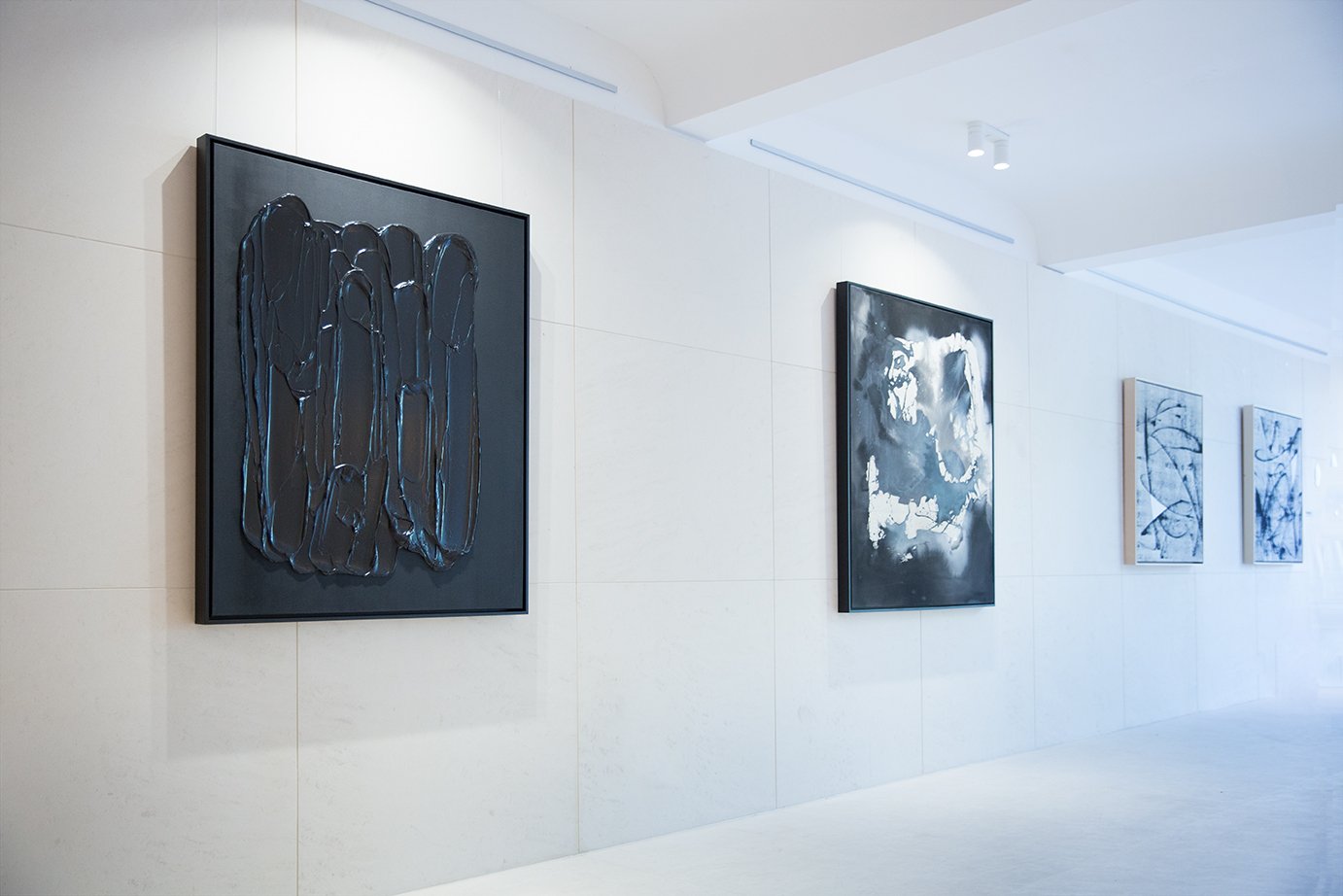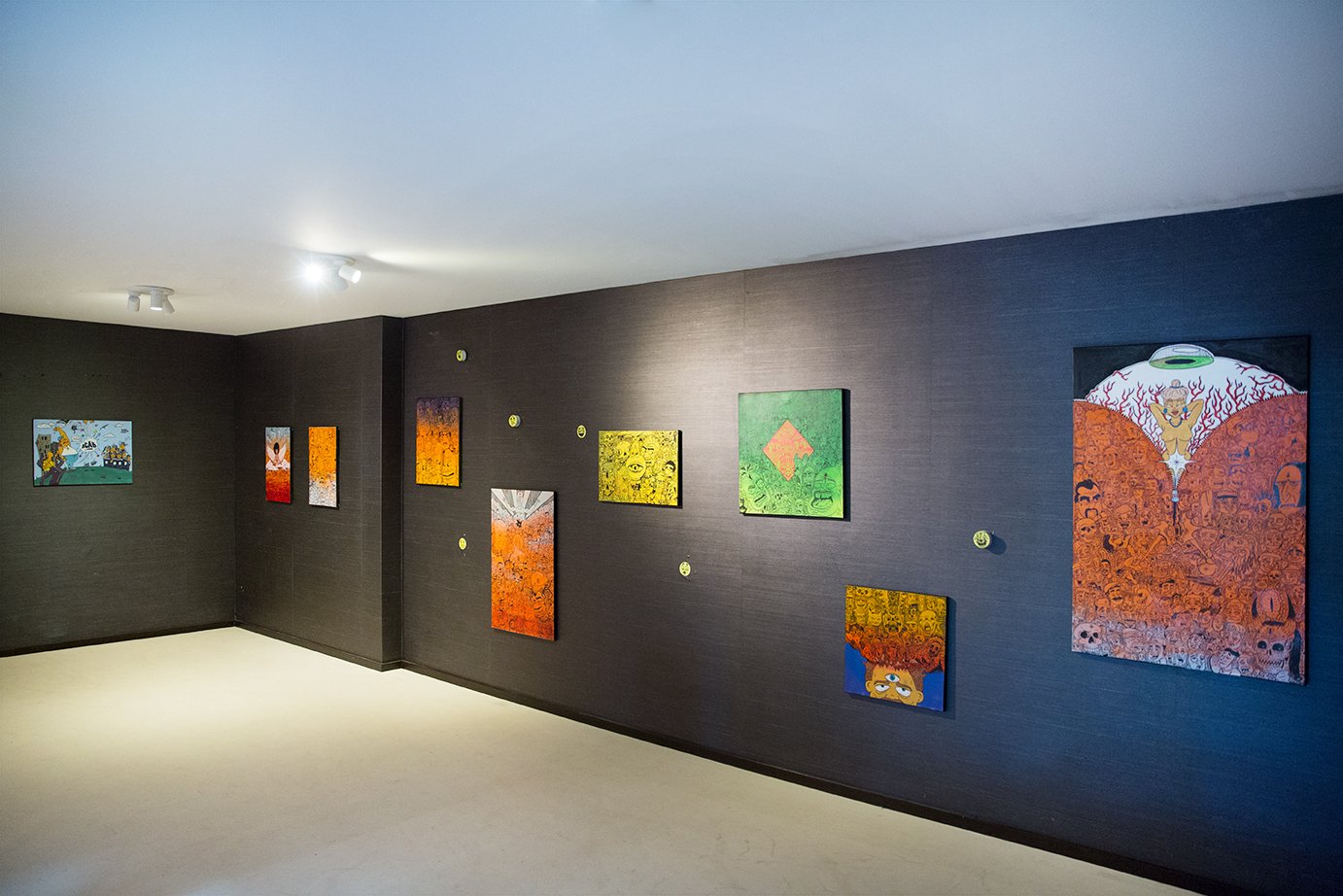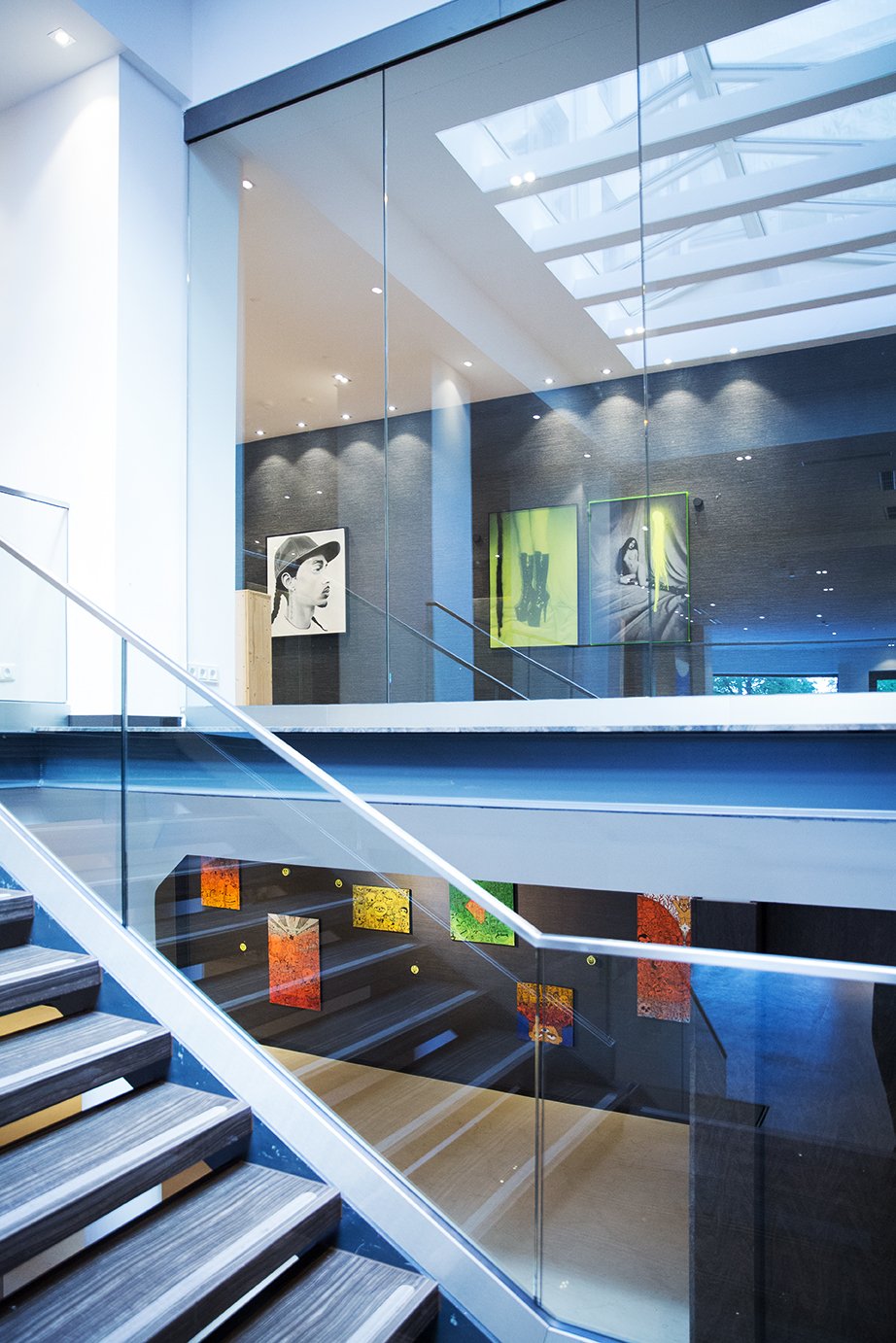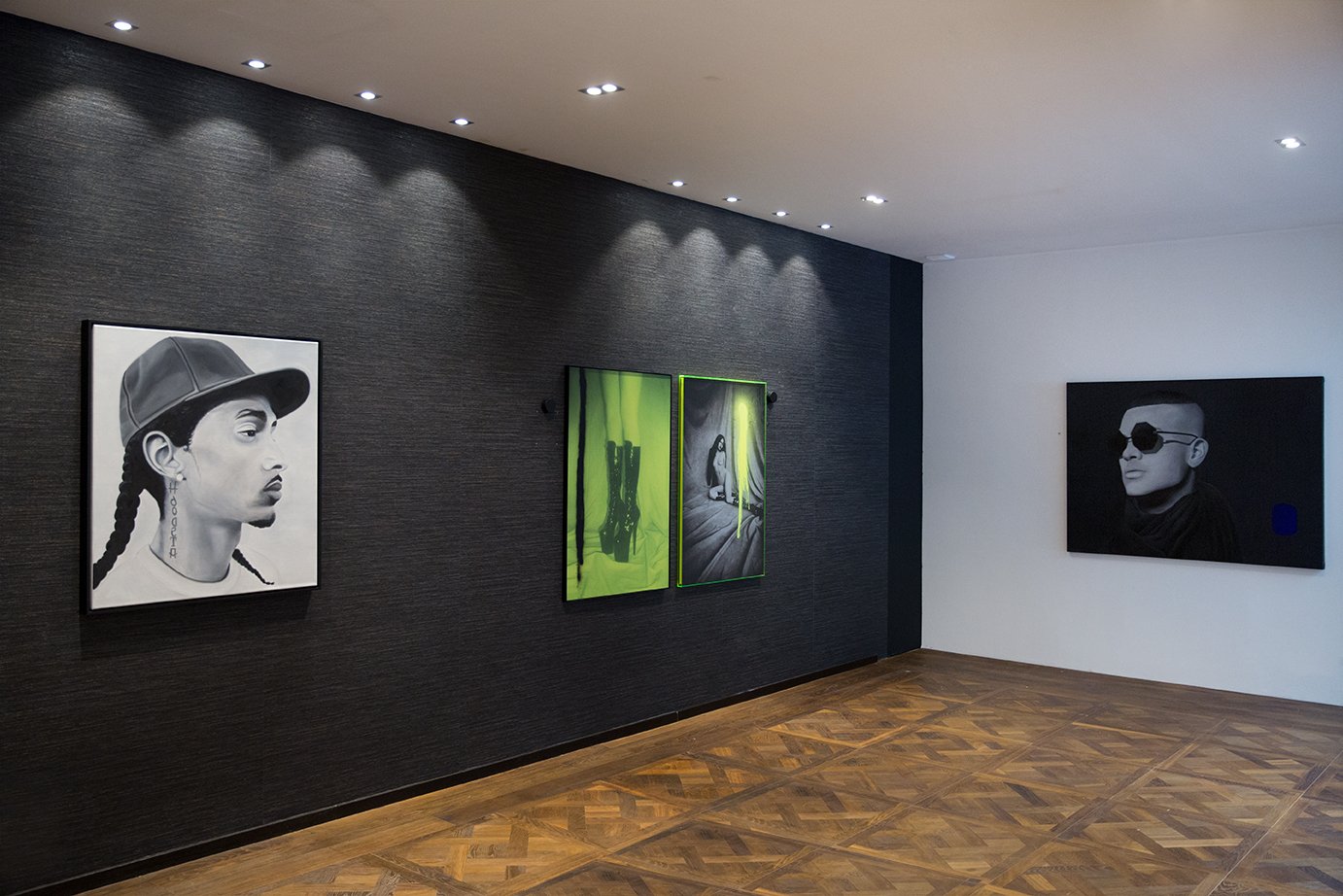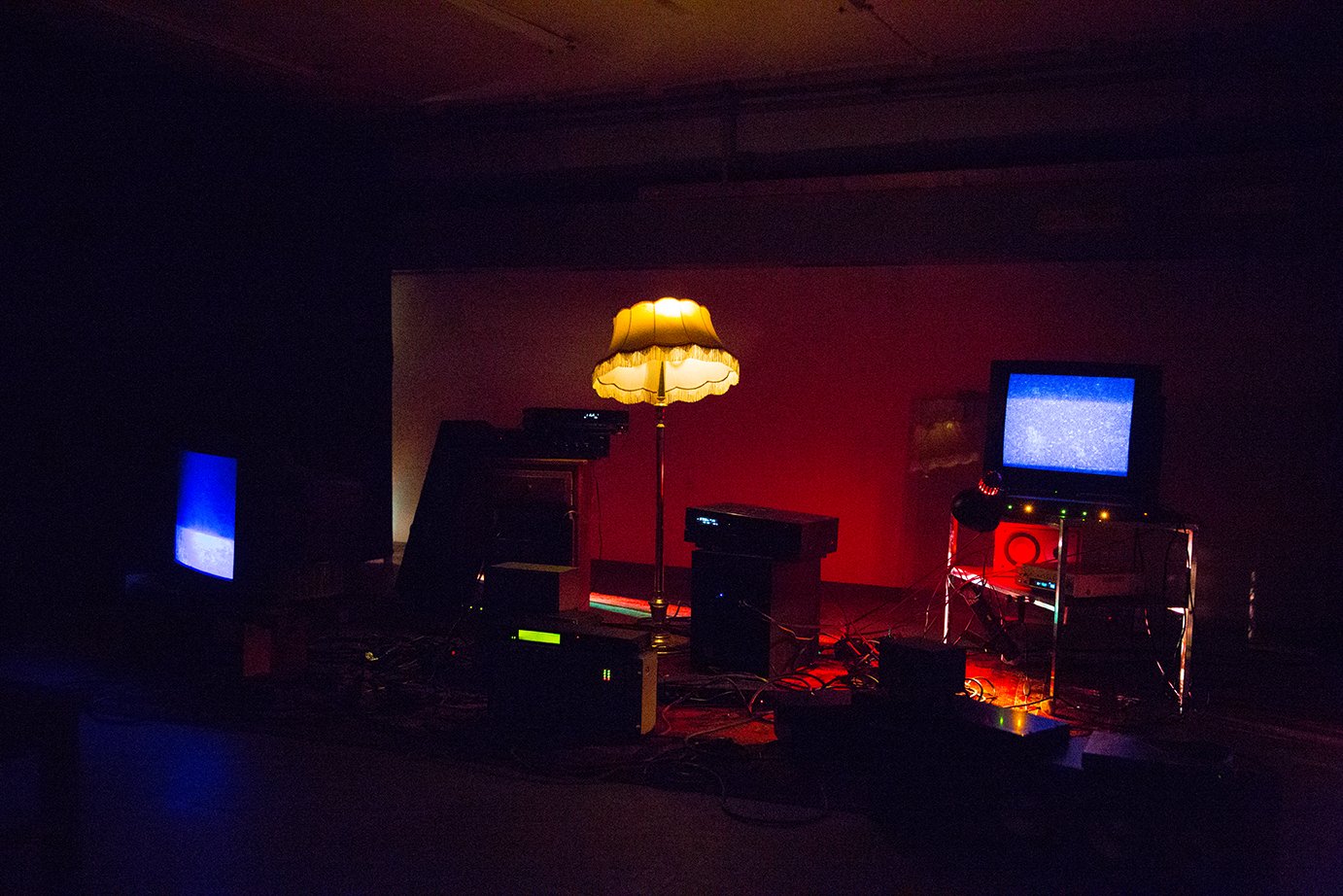THE SPACE // March, April, May 2024
presents
T R A N S I T I O N S
works and creative productions by
TJORG DOUGLAS BEER, MARIE BOISELLE, SARICE BRUDET, ELENA BULYCHEVA, CHIAO-HAN CHUEH, KYLE EGRET, DOUMORH EL-RIZ, ANNA LENA GRAU, CHEN GUO, DANIEL HAHN, GREGOR HILDEBRANDT, DANIEL HÖRNER, JAKOB HARMS, SIMON HEHEMANN, HELEN HU, FLORIAN HUBER, NANHEE KIM, SUJIN KIM, JAN KOSCHNITZKE, NICHOLAS MBOYA, TINA OELKER, STEFAN PFEIFFER, HUSSEIN EL RAYESS, IMAD EL RAYESS, JESSICA REES, ANSELM REYLE, ANTON SCHÖN, LENA SCHRAMM, ANNA STEINERT, NICK WACHS, PAUL WALLINGTON, CHRISTOPH WÜSTENHAGEN, THOMAS ZIPP, TEMORSCHA ZOLTANI
07.03. – 11.05.2024
The exhibition „T R A N S I T I O N S“ brings together the work and creative productions of 34 contemporary artists presenting a diverse range of positions.
The exhibition wants to explore interconnected themes of identity, culture, the environment and globalization emphasizing the complexities of our ever-evolving and transforming world. Contemplating the fluid nature of identity and the ways in which we navigate cultural shifts and transformations.
Transition, a change or shift from one state, conditions, subject, place, etc. to another. A metamorphoses - creating, developing, evolving something new or different from a pool of the already existing.
The exhibition draws inspiration from the ideas and writings of renowned thinkers Chus Martínez, Edouard Glissant and Nicolas Bourriaud.
Spanish writer and curator, Chus Martínez, has a background in philosophy and art history. Her book "The Complex Answer" is a compelling exploration of the complexities of contemporary art and culture. Martinez delves into the multifaceted nature of artistic expression and the ways in which art can challenge conventional thinking and spark meaningful dialogue.
Drawing on her expertise as a curator and art historian, Martinez examines the intersections between art, politics, and society, offering insights into the role of artists in addressing pressing social issues. She emphasizes the nuanced layers of meaning embedded within artworks and the ways in which they can provoke thought and inspire change. „Can artworks and exhibitions be more than the mere exposure to individual practices, cultural trends, or taxonomic ordering of contemporary patrimony? “
She emphasizes that exhibitions are not only a place to show, but a surrounding to enact the values humans care for most and a place where these values of life are being protected.
„Being in an exhibition is, in other words, like walking on a future cloud. It may seem rudimentary, standardized, even boring and yet it allows for a physical superposition of materials and thinking logics that is effective and has a deep impact in our senses and memory. I trust exhibitions to give birth to energies able to ameliorate social polarization. I also trust exhibitions with the force that may activate a renewed sense of citizenship and social and community-based solidarity and empathy. “
"The Poetics of Relations" by French philosopher and writer Edouard Glissant is a seminal work that explores the interconnectedness of cultures, identities, and histories. In this book, Glissant examines the concept of relationality and the ways in which individuals and communities are shaped by their interactions with others. He emphasizes the importance of embracing diversity and difference, advocating for a more inclusive and interconnected world and reflect themes of interconnectivity, hybridity, and multiplicity. “I can change through exchanging with others, without losing or diluting my sense of self.”
"Inclusions" by Nicolas Bourriaud is a thought-provoking exploration of the concept of inclusion in contemporary art and society. In this book, Bourriaud emphasizes the idea of creating spaces and experiences that foster connection, dialogue, and understanding among individuals from diverse backgrounds.
Drawing on the principles of relational aesthetics, Bourriaud argues that art has the power to bring people together and bridge cultural divides. By emphasizing collaboration, interaction, and exchange, he suggests that art can serve as a catalyst for social change and transformation.
Art has the ability to push boundaries and question established norms. Our exhibition TRANSITIONS would like to serve as a space for reflection and introspection, inviting the individual to consider the myriad perspectives and interpretations that art can offer and foster connections.
Sources:
Chus Martinez: The Complex Answer
Édouard Glissant: Poetics of Relation
Édouard Glissant: Kultur & Identität. Ansätze zu einer Poetik der Vielfalt Édouard Glissant: Philosophie der Weltbeziehung. Poesie der Weite Édouard Glissant & Hans Ulrich Obrist: The Archipelago
Nicolas Bourriaud: Relational Aesthetics
Nicolas Bourriaud: Plant B – Climate Change and the New Sublime Nicolas Bourriaud: Inclusions: Aesthetics of the Capitalocene
THE SPACE // Nov, Dec 2023, Jan 2024
presents
S H A P E D B Y T I M E
works and creative productions by
TJORG DOUGLAS BEER, SASCHA BOLDT, SARICE BRUDET, TIM BRUENING, ALEJANDRA CAICEDO, HYUNJIN CHOI, DANIEL ECKOLDT, LORENZ EGLE, CHEN GUO, GREGOR HILDEBRANDT, OLIVER KAPS, JAEWON KIM, SUJIN KIM, CLAUDIA KLEIN, LARA KOCH, KAI LIETZKE, CHRISTINE LIPSKI, TINA OELKER, EGLE OTTO, ANSELM REYLE, ANSELM REYLE, CAMILLE SCHAEFFER, CHRISTIAN SCHOPPE, CHRISTIAN VOIGT, PAUL WALLINGTON, MEGGIE WEINHEIMER, SORAYA WÜLLNER, THOMAS ZIPP, TEMORSCHA ZOLTANI, MARTHA ZONOUZI, SOUND BY RAWR
23.11.2023 – 27.01.2024
The exhibition „SHAPED BY TIME“ brings together the work and creative productions of 30 contemporary artists presenting a diverse range of positions.
The exhibition wants to reflect on the intricate relationship between time, culture and the environment emphasizing the complex and multifaceted nature of time and its influence on our lives.
As humans we navigate through different temporal dimensions – past, present, and future – encountering impermanence, decay and transformation as integral aspects of our existence.
This exhibition wants to encourage a dialogue with time - challenging our perception of time by highlighting the interdependence and dynamic interplay between time and nature. Emphasizing the delicate balance between human intervention and the forces of nature.
Edouard Glissant, a prominent Caribbean philosopher, believed in the importance of cultural diversity and the interconnectedness of all cultures. His concepts emphasize the constant exchange and blending of cultures, resulting in the creation of new identities and narratives. Through Glissant's lens, the individual can explore how time is not a linear progression but a complex web of interwoven stories, encounters and experiences. Our identities are shaped not only by our personal experiences but also by the historical and cultural contexts in which we exist.
In his seminal work, "Poetics of Relation," Glissant explores the concept of relational identity and its profound connection to the passage of time.
The Fluidity of Identity:
Glissant argues that identity is not fixed but rather fluid, constantly evolving through encounters with others and the world around us. Time acts as a catalyst for this evolution, allowing to transcend boundaries and embrace multiple perspectives. As we navigate through different temporal dimensions, we are shaped by the experiences, memories, and narratives that intertwine with our own.
Historical Contexts:
Identities are deeply rooted in historical contexts, which provide a framework for understanding ourselves and others. Time allows us to reflect on the legacies of the past, acknowledging both the triumphs and injustices that have shaped our present reality. By engaging with history, we gain a deeper appreciation for the complexities of identity formation and recognize the importance of inclusivity in shaping a more just future.
Cultural Diversity:
Time also plays a crucial role in shaping cultural diversity. As societies evolve over generations, traditions, languages and customs transform - reflecting the dynamic nature of human existence. Glissant emphasizes that embracing cultural diversity fosters dialogue and enriches our understanding of one another. Through time, we learn to appreciate the beauty and complexity of different cultures, recognizing that they are integral to our shared human experience.
Shapes, Marks, and Traces:
In contemplating the influence of time on our existence - shapes, marks, and traces that are left behind as testaments to the passage of time are of great significance. These physical imprints carry within them narratives of growth, decay, and transformation, embodying the essence of Edouard Glissant's concept of "trace" – the remnants of past experiences that shape our present identities.
Just as Glissant emphasizes the importance of acknowledging historical contexts in understanding ourselves, these shapes and marks serve as tangible reminders of our collective history. They bear witness to the struggles and triumphs of those who came before us, leaving an indelible imprint on our cultural landscapes. Through time, these imprints become part of our shared heritage, connecting us to a larger narrative that transcends individual experiences.
Nicolas Bourriaud, a contemporary art theorist, introduced the concept of "relational aesthetics." He argued that art should be seen as a social encounter, a platform for dialogue and interaction. By examining Bourriaud's ideas, we investigate how time is shaped through our interactions with art and how it can foster new perspectives and connections. His concept of relational aesthetics further expands upon Glissant's ideas. Bourriaud suggests that art has the potential to create social bonds and foster connections between individuals.
Shapes, marks and traces also connect to the concept of the new sublime. The new sublime challenges traditional notions of beauty by embracing the awe-inspiring power found in natural processes and phenomena. As we witness the erosion of rocks or observe how nature reclaims man-made structures over time, we are confronted with a sublime beauty that lies beyond human control. He argues that in an era marked by environmental crises and technological advancements, our perception of the sublime must evolve. The new sublime embraces the awe-inspiring power found in natural processes and phenomena, inviting us to reflect on our place within a rapidly changing world.
Art has the ability to use the transformative power of time and contemplates its impact on our individual and collective identities, our social interactions and structures. Time acts as a catalyst for change, molding our identities and existence through a constant interplay between past, present, and future.
Sources:
Édouard Glissant: Poetics of Relation
Édouard Glissant: Kultur & Identität. Ansätze zu einer Poetik der Vielfalt
Édouard Glissant: Philosophie der Weltbeziehung. Poesie der Weite
Édouard Glissant & Hans Ulrich Obrist: The Archipelago
Nicolas Bourriaud: Relational Aesthetics
Nicolas Bourriaud: Plant B – Climate Change and the New Sublime
Nicolas Bourriaud: Inclusions: Aesthetics of the Capitalocene
THE SPACE // Sept, Oct 2023
presents
S E N S E OF B E L O N G I N G
works and creative productions by
ARMIN BOEHM, SARICE BRUDET, ORNELLA FIERES, ISABELLE GRAEFF, GREGOR HILDEBRANDT, HELEN HU, THEO HUBER, LUDWIG KREUTZER, KAI LIETZKE, DAVID RODRIGUEZ MUNOZ, TINA OELKER, HANNAH PARR, JEANNINE PLATZ, ANSELM REYLE, NICK WACHS, DERK INSA WAGNER, IDAN WEIß, THOMAS ZIPP, TEMORSCHA ZOLTANI, MARTHA ZONOUZI, SOUND BY RAWR
10.09 – 26.10.2023
The exhibition „SENSE OF BELONGING“ brings together the work of 20 contemporary artists presenting a diverse range of positions. The exhibition wants to explore and reflect on the intricate and multifaceted aspects of belonging, exploring its significance in shaping our identities, fostering community, and nurturing a sense of purpose and a sense of self.
We live in a globalized, rather off-balanced and interconnected world defined by a correlation between the physical and virtual engagement with the surrounding where screens, interfaces and algorithms become a dominating factor. How does an entangled world and the status quo shape a sense of belonging on a global scale? How does a not static sense of belonging evolves and adapts to the changing world around the self? How do societal shifts, globalization, and technological advancements impact a sense of belonging and how can the self navigate and embrace new forms of connection and community?
Édouard Glissant, a French philosopher and poet who grew up in Martinique, emphasizes that a sense of belonging emerges from embracing diversity and recognizing the interconnectedness of cultures. His concept of "Poetics of Relation" points out the importance of dialogue, exchange, and creolization as means to foster a collective identity that transcends borders. Glissant's works, such as "The Poetics of Relation" invite to reflect on the power of cultural hybridity and the potential for a global sense of belonging. His theories bring up central questions about the construction of identity, memory, and the world humans strive to create. “I can change through exchanging with others, without losing or diluting my sense of self.” By examining the complexities of identity formation, the self can aim to foster a deeper understanding of how our unique characteristics contribute to our sense of belonging in the world.
Nicolas Bourriaud, a French art critic and curator, explores the notion of belonging through his concept of "Relational Aesthetics." He argues that art can create social bonds and generate a sense of belonging by engaging viewers in participatory experiences. Bourriaud's influential book, "Relational Aesthetics," challenges traditional notions of art as a static object, emphasizing instead the importance of human interaction and shared experiences. Through his ideas, the self can examine how art can foster connections and create spaces for belonging in our increasingly fragmented society. Bourriaud highlights the role of art in bridging gaps and creating a shared sense of identity. His works emphasize the transformative power of art in creating social bonds and fostering a sense of belonging within communities.
Charles Taylor, a Canadian philosopher, focuses on the politics of recognition as a crucial aspect of belonging. He argues that individuals need their identities to be recognized and affirmed by others in order to feel a sense of belonging. Taylor's seminal work, "The Politics of Recognition," explores the complexities of identity formation and the struggles faced by marginalized groups in their quest for recognition. By examining Taylor's ideas, we delve into the challenges and possibilities of creating inclusive societies that acknowledge and value diverse identities.
Through these unique perspectives, the exhibition aims to explore questions and streams of thought about the intricate relationship between identity, culture, and the feeling of belonging in today's diverse and interconnected world. Art in this context has the ability to contribute that an individual can live their authentic self.
Sources:
Édouard Glissant: Poetics of Relation
Édouard Glissant: Kultur & Identität. Ansätze zu einer Poetik der Vielfalt
Édouard Glissant: Philosophie der Weltbeziehung. Poesie der Weite
Nicolas Bourriaud: Relational Aesthetics
Charles Taylor: Die Politk der Anerkennung
THE SPACE // July, August 2023
presents
W A V E S
works and creative productions by
SARICE BRUDET, NICULAI CONSTANTINESCU, TRONJE THOLE VAN ELLEN, MICHAEL GRIEVE, MARLET HECKHOFF, AMELIE VON HEYDEBRECK, ARIANE HOSEMANN, CLAUDIA KLEIN, KAI LIETZKE, CHRISTINE LIPSKI, LUCKY BAMBINO, DAVID RODRIGUEZ MUNOZ, TINA OELKER, VIGDIS, TEMORSCHA ZOLTANI, MARTHA ZONOUZI, SOUND BY RAWR
27.07 – 31.08.2023
The exhibition „WAVES“ brings together the work of 15 contemporary artists presenting a diverse range of positions and wants to explore questions and streams of thought about the concept and idea of „WAVES”. We live in a globalized, rather off-balanced and interconnected world defined by a correlation between the physical and virtual engagement with the surrounding where screens, interfaces, algorithms and concrete walls become a dominating factor.
In physics, mathematics, engineering, and related fields, a WAVE is a propagating dynamic disturbance, (change from equilibrium) of one or more quantities. In other words or in a figurative sense: „ups“ and „downs“ sometimes striving towards a state of balance in a constant movement.
Édouard Glissant, a French philosopher and writer who grew up in the Caribbean, explored the concept of waves as a metaphor for the interconnectedness of cultures and the fluidity of identities. His ideas on archipelagic thinking were revolutionary. Glissant's archipelago thinking refers to his philosophical concept that emphasizes the interconnectedness and diversity of cultures, identities, and histories. It suggests that the world is made up of multiple islands, each with its own unique characteristics, but all connected through a network of relationships. An archipelago, literally, is a cluster of small islands. When Glissant uses the word, he imagines something which exists in opposition to the staid constraints of the continents; which, drifting, “must” encounter the realities of different, foreign places. His theories bring up central questions about the construction of identity, memory, and the world humans strive to create. “I can change through exchanging with others, without losing or diluting my sense of self.”
Glissant believed that embracing this diversity and recognizing the value of different cultures can lead to a more inclusive and harmonious society. He argued against the idea of a single, dominant culture or identity, advocating instead for a celebration of difference and a rejection of homogenization.
Archipelago thinking encourages to view the world as a complex tapestry of interconnectedness, where each individual and culture contributes to the overall richness and complexity of the whole. It invites to appreciate and learn from the diverse perspectives and experiences of others, fostering a sense of unity in diversity. His ideas inspire to reflect on the constant movement and exchange that shape our world.
Nicolas Bourriaud, a contemporary art theorist, introduced the concept of relational aesthetics, which emphasizes the importance of social interactions in art. Waves, in this context, can be seen as a representation of the dynamic relationships between artists, artworks, and audiences. Bourriaud defined the approach as "a set of artistic practices which take as their theoretical and practical point of departure the whole of human relations and their social context, rather than an independent and private space." Bourriaud explored the impact of climate change on contemporary art through the lens of the sublime, a notion defined in the 18th century by the philosopher Edmund Burke. The New Sublime refers to a contemporary approach to the sublime, where artists explore the awe-inspiring and overwhelming aspects of nature and technology. WAVES in all their different forms (in nature, physics etc.) with their immense power and beauty, but also with their danger and sometimes unpredictable transformation serve as this new sense of the sublime.
Bourriauds emphasizes that the awareness of climate change has modified the collective relationship to the earth in many ways, but it also impacts the human gaze. If humans used to regard the planet as merely a backdrop for their activities, a decoration - an environment - they now feel completely engulfed by its atmosphere, soils, and oceans, which have become potential threats. Within this context, the old notion of the sublime finds a new life in art.
Frequencies, vibrations, and energies are fundamental elements of WAVES. Art has the ability to use this transformative power of „WAVES“ and their impact on our senses and the self.
Sources:
Édouard Glissant: Poetics of Relation
Édouard Glissant: Kultur & Identität. Ansätze zu einer Poetik der Vielfalt
Édouard Glissant: Philosophie der Weltbeziehung. Poesie der Weite
Édouard Glissant & Hans Ulrich Obrist: The Archipelago
Nicolas Bourriaud: Relational Aesthetics
Nicolas Bourriaud: Plant B – Climate Change and the New Sublime
THE SPACE // May, June 2023
presents
B E G E G N U N G E N
works and creative productions by
CARLOTTA BARTELS, MARIE BOISELLE, SARICE BRUDET, CHIAO-HAN CHUEH, THOMAS HAUPT GREGOR HILDEBRANDT, HELEN HU, THEO HUBER, ALEXANDER ISKIN, KAI LIETZKE, PHOEBE MINOUCHE, ANSELM REYLE, JETTE ROPERS, SELASSIE, MILEN TILL, RUSCHA VOORMANN, NICK WACHS, THOMAS ZIPP, TEMORSCHA ZOLTANI, MARTHA ZONOUZI, SOUND BY RAWR
Vernissage, 11.05.2023, 6 -10 PM 12.05 – 30.06.2023
The exhibition “ B E G E G N U N G E N” brings together the work of 20 contemporary artists presenting a diverse range of positions.
The exhibition wants to explore questions and streams of thought about the essence of „encounters” in a globalized and interconnected world defined by a correlation between the physical and virtual engagement with the surrounding.
French writer and philosopher Édouard Glissant formulated the following phrase:
“I can change through exchanging with others, without losing or diluting my sense of self.”
His theories bring up central questions about the construction of identity, memory, and the world humans strive to create. Glissant had developed an experimental and transdisciplinary project, “a museum that seeks”, as opposed to Western museums that “have found”. The inventor of the concept of mondialité, defined his museum as “the place where places in the world are brought into contact with other places in the world”. Aiming for a great diversity of representations and a multiplicity of voices, emphasizing the individual sensibility of artists over the great universalist narratives.
Encounters pave the way to independent thinking and new situations arise from encounters between differences.
According to Hegel in order to be able to unfold their full power, an idea must meet another idea. A thesis alone cannot really be expressed without antithesis, without negation, without confrontation with it. The same applies to the individual. The confrontation with another consciousness is necessary in order to learn against its differences, to position oneself, to know one's own worth and to develop further. How are we supposed to know where we are and who we are without confronting the difference? Without an encounter with the other, an encounter with ourselves is not possible. An individual must experience being different in order to grasp their uniqueness. The objective recognition of oneself. Without the experience of being different the Self can’t know itself. In order to develop, the individual needs to encounter others.
Édouard Glissant says that culture is created through differences. Thinking about origins in order to create something new. Whenever different civilizations meet, friction creates domination, but also resistance and this creates something again. To understand or sense the world better, that's the goal when looking at art. If you go to an exhibition and don't have any questions afterwards, then it's probably not a good exhibition. According to Glissant digital technologies create worldwide connections at unprecedented speed, they destroy a central prerequisite for real encounters through their leveling means: the recognition that we always don't understand each other, that not everything is translatable. In his last essay, Glissant still insists on the concept of opacity: "Because you have the right to be incomprehensible, first and foremost to yourself." The unpredictability of encounters is therefore a source of hope.
Art has the ability to create new spaces of encounter, creating worlds and a dialog. Artists have always created worlds, even not in a technological sense. No matter what medium artists use, they are portals to world creation.
Encountering the other has the power to change something, shape the Now and to offer visions.
THE SPACE // 2022
The exhibitions at THE SPACE // are centered around the human mind, body and soul and explore how the Self is transformed and shaped by society, technology and its relation to nature and the cosmos.
How does the Self and the perception of the Self correlate with the outside and its surrounding in a seemingly unpredictable world shaped by globalization, technology and climate change?
How can the Self retain optimism to create change and disconnect from set and conditioned perceptions, preconceptions and prejudices in order to alter these perspective, question the status quo and self-limiting beliefs?
The artists explore notions and reasoning of contemporary consciousness, constructive abstraction, inner and outer worlds. Questions center around the intuitive mind vs the rational, resonance, energies and frequencies, concepts of time and balance, empathy and cultural diversity.
For Édouard Glissant (French writer, poet and philosopher) the "poetics of the relationship" (Poétique de la Relation) stands for a human identity that is defined by the variety of relationships and not by an ethnic one, namely descent. In this context, he distinguishes between “globalization” (Fr. mondialisation) and “globality” (Fr. mondialité): “What is called globalization is assimilation at the lowest level, the rule of multinational corporations, standardization and unregulated liberalism at the markets of the world. But for me it is just the flip side of a wonderful reality that I call globality.” Globality and globalization are two sides of the same phenomenon. By "globalization" Glissant means the capitalist project of multinational corporations and the associated cultural leveling (standardization). GLOBALITY, on the other hand, harbors productive potential through creative interactions between cultures. This is how complex cultures (cultures composites) arise.
The exhibitions would like to emphasize the optimism of GLOBALITY and each exhibition explores different nuances of this subject matter and streams of thoughts.
The first exhibition in 2022 with the title AN (SICHT) EN was based on “Perspektivwechsel” / “ Change of Perspective” and the optimism of Gloabality in contrast to Glabalization.
Vernissage 30.06.2022 / Finissage 25.08.2022
The second exhibition IDENTITY explored ways and mindsets of defining identity detached from marginalizing, labeling and boxing concepts. Seeking ways of true identities to nourish complex and diverse cultures.
Vernissage: 08.09.2022 / Finissage 27.10.2022
The third exhibition DAS GE (FÜHL) ZU (FÜHL) EN will center around different perspectives what it means and implies “to feel” in a contemporary and interconnected world. Exploring balancing acts between rationality and intuition, balancing acts between different mindsets and perceptions.
Vernissage 17.11.2022
THE SPACE // Nov, Dec 2022
presents
DAS GE(FÜHL) ZU (FÜHL)EN Vernissage 17.11.2022 / Closing 30.11.2022
works and creative productions by
MARIE BOISELLE, SARICE BRUDET, NEZAKET EKICI / OPERNDORF AFRIKA, DANIEL ECKOLDT, GREGOR HILDEBRANDT, ANDY HOPE 1930, ARIANE HOSEMANN, HELEN HU, NANHEE KIM, KAI LIETZKE, ANSELM REYLE, NICK WACHS, THOMAS ZIPP, TEMORSCHA ZOLTANI
THE SPACE // June, July, August 2022
presents
AN (SICHT) EN Vernissage 30.06.2022 / Finissage 25.08.2022
works and creative productions by
SARICE BRUDET, KAI LIETZKE, JETTE ROPERS, NICK WACHS, EVA WOCHNER, TEMORSCHA ZOLTANI
THE SPACE // Sept, Oct 2022
presents
IDENTITY Vernissage: 08.09.2022 / Finissage 27.10.2022
works and creative productions by
LINDA BÖSE, SARICE BRUDET, NOAH KRAUS, KAI LIETZKE, CHRISTINE LIPSKI, NICK WACHS, TEMORSCHA ZOLTANI



